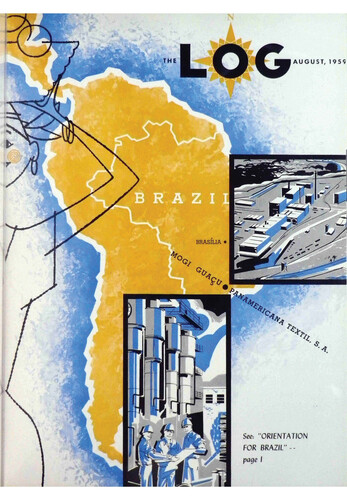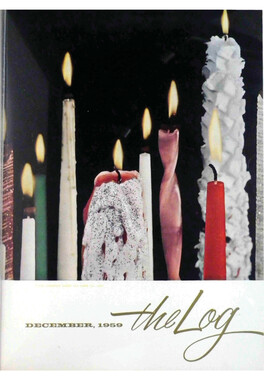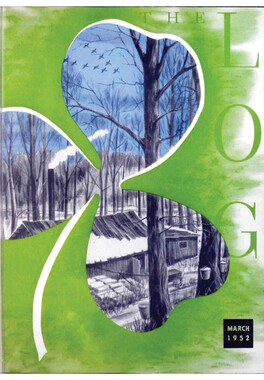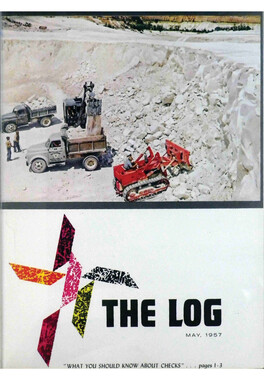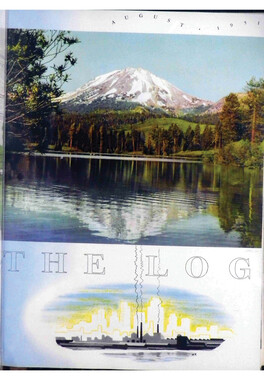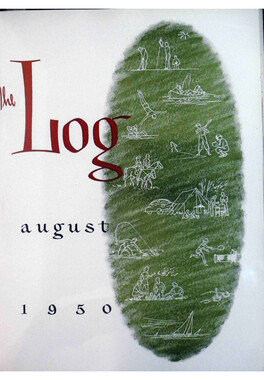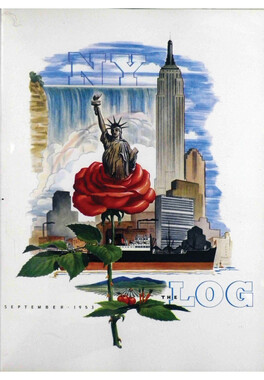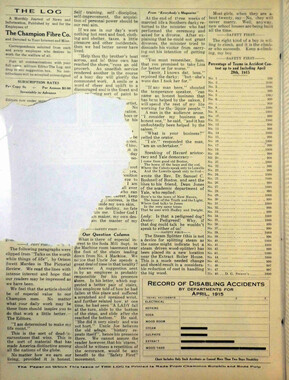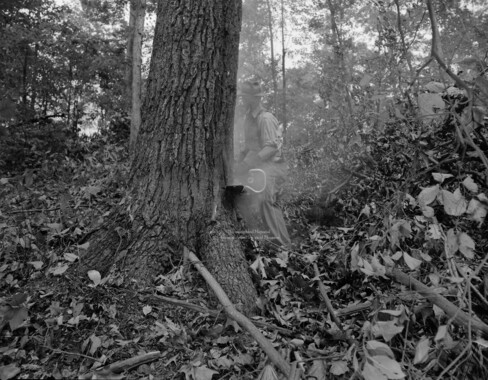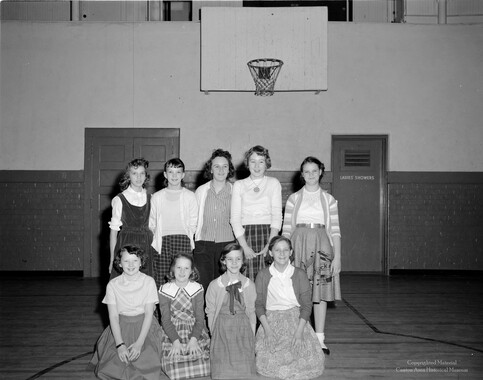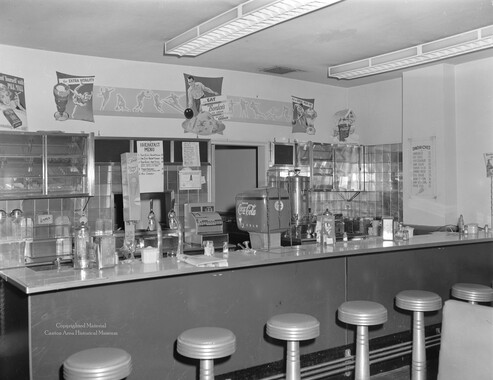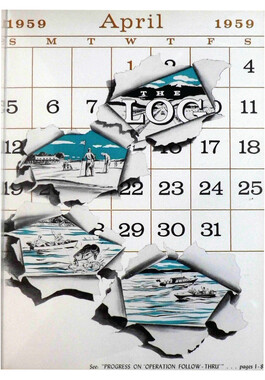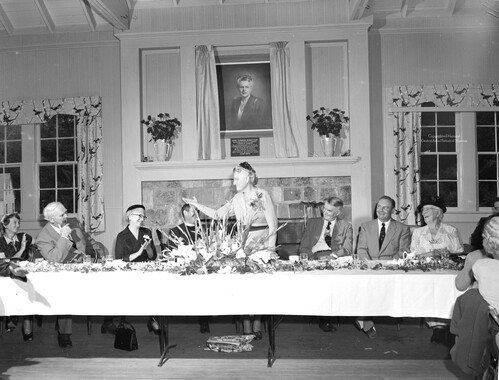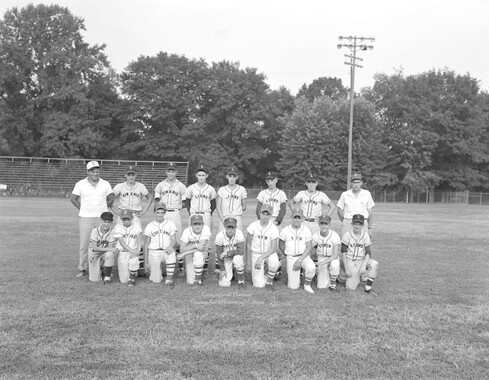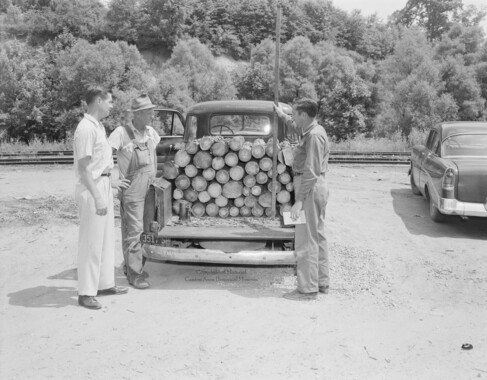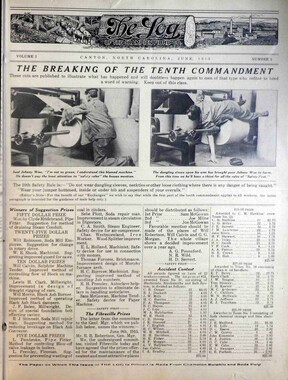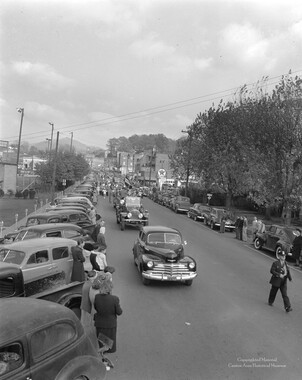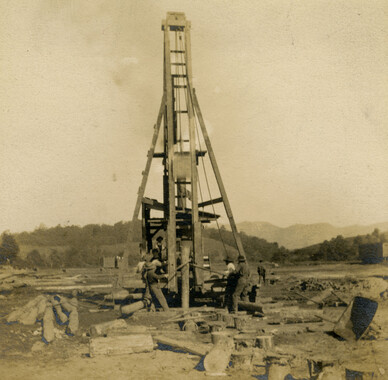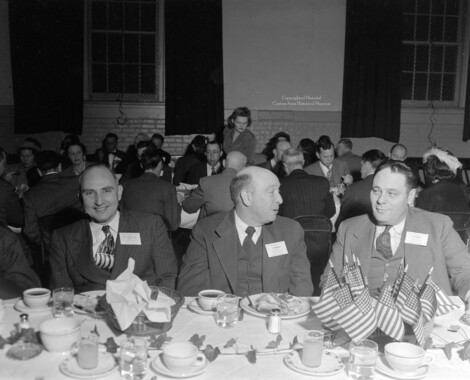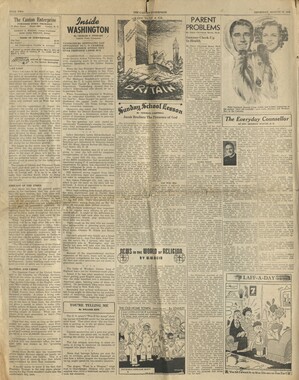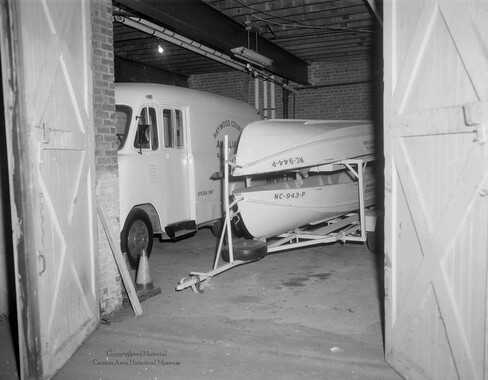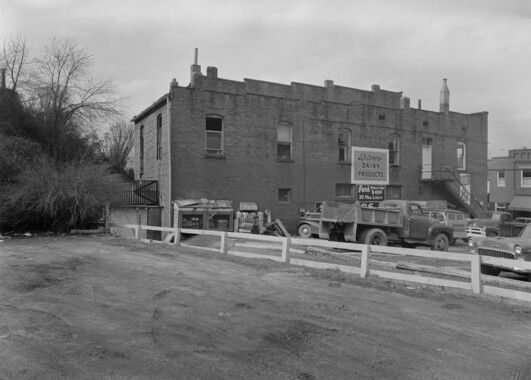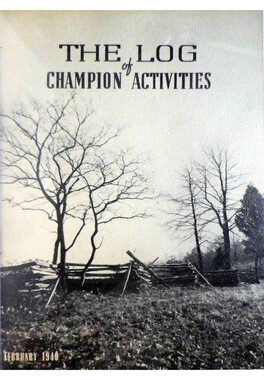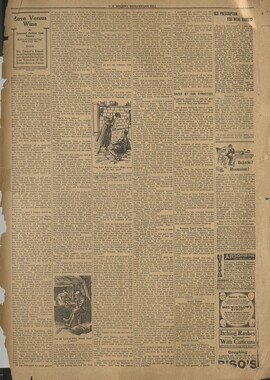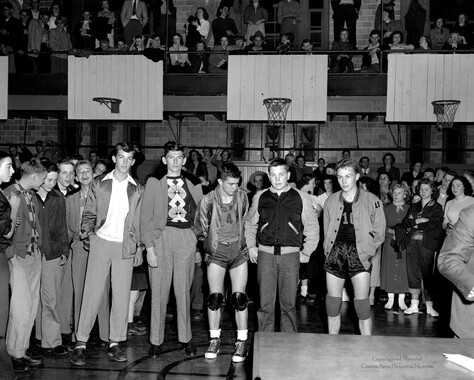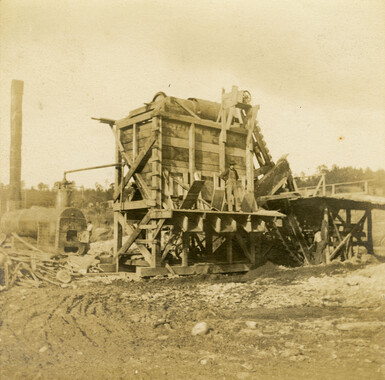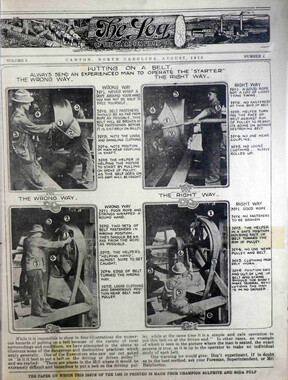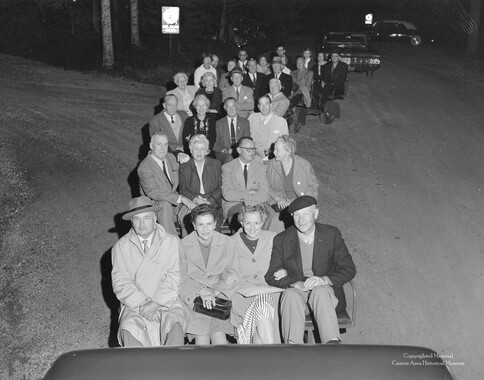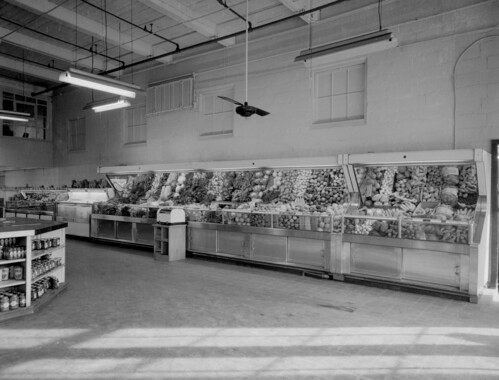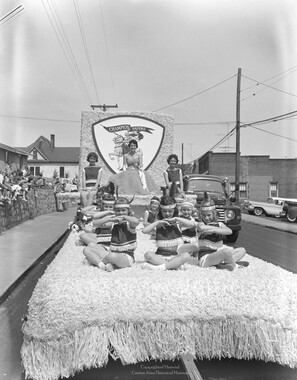• ' • THE ' f . . ' .BRASI"L IA • ·- AUGUST, 1959 See: "ORIENT A TION FOR BRAZIL" -• page I ' • From the Editor·s Ncrru Heberer, former Ohio h. mpioJl, .g._, ive · us [irs ·-hand nc,~-- this nwuth on the "uoin~ -on '" of m oulh f th b rder Cham- .... pion '" in Brat il. 1'\ rm an i .ome tw.o d)LCn other Ch. tnpi n · J.l' at l\fogi G ua n , nc ~u' ao Paul , to l1 lp in the con tru Lion and ·tart-up of ur new pulp mill and to train .Brazilians [or fu.tur operation oi the miil. Our Champion have foun l th ir fo reign a· igmu .nt excitino·, to a · the J<eas t. And as N rm ptu · it, they ha,"e lend many "bonus experience .. " On pages 6-9, "Champions in B1·:u.it'' you 'll read about ome of the u nus ual cu t::>m · of the Brazilian and how o ur fo lk are .adapting to a new ·way of l ife. • \ 'Ve are grateful to Jeanne Trell es, Corporate DeYelopment, for an explanation of tl1e odd li ttle P ortug u ese mark sprinkled throughout the Brazil stories and on the cover. 1 t i a diacritical mark ca.Ued a ced illa (t;:). The cedil.la '"~'a:s originally written as "CZ" ' centurie. <Vgo and served to give a sibilant or "S'' sound to the C where it would otherwise be pronounced like a K. As tixne passed the "C~" became "f '. Finally the Z lost its original form aLtogether and became just a smaU appendage on the C (c;:). 1\llogi Gu at;:u, the site oi our new pulp rn1Jl, is pronouncetl .--.___"MOH-.gee gwah-SUE." • T xas Charnpion Justin Tha er, wh o h (IS written a tlH~ r interesting feature Cor Th LOG, t1'1;is tnon rh tell,<; a boul " Pack 9 J - First, Bigg-es t and Hest" Of.! p·1gc: I 2. Jus Lin has he 'n anive for many years in Scouting . . He hold- the Sc{H.ltef's K ·y Awa.rd for :>el' ing . in various <;1l '!;>aci ties J rom Cu[)mast .r- 111 n;.,. ld ·L CoJm:n ilurioncr, .Last: ye;u- .Juslin rc~ tLJrn ecl ~~ :; Gubrnaster of Champwn-)fpOJJ ·orcel P:u,k 9 1. "Sc01Hing- ha b en my hobh, for 1hc p<:~ st 12 years," "S<!ys Justin. " .1 know nf no graler reward than watching t:ht':st: SC:outs of mirw grow into . fine you.ng 1<1'\t n." • • • • • • • • • • • • • • • • • • • • • • • • ' • • • • • • • • • • • • • • • • • • • • • • • • • • • • • • • •• • • • • • • • • • • • • • • • • • • • • • • • • • • • • • • • • • • • • • • • • • • • • • • • • • • • • • • • • • • • • • • • • • • • • • • • • • • • • • • • • • • • • • • • • E AUGUST, 1959 VOL. XLII , NO. 8 C hampion Pape r and Fibre Company General Office • .. HAMILTON, OHIO Mills or ... HAMIL TON, OHIQ • CANTON, NORTH CAROLINA PASADENA, TEXAS • SANDERSVILLE, GEORGIA Editor . .. STEWART J-ONES Assistant Editor .•• DONALD OlEXIQ Division Editors • .. Ohio, MERLE BAKER . Carolina, JAMES DEATON .•• Texas, KEN REED Editorial Assistant • . • ' EUNICE B. HUGHES EDITOR'IAL STAH 0 n,_i.O o·I VI·S I·.O n •• • Bob Banett, Me:rle Bay nes, Joe .Blevens, Blondie Caldwe l·l ( photo~mphn) . . v.restey Cobb, Paul Newkirk, Otto Reid, J ohn Schmitt, George Steiner, Bill T hompson, Dell.a Hicks. Caroli'na Divis·ion ... U. Davis, Rtll K i'rl lam! C. W. Hardin, Harry Holland, Walter Ho lLon, Geue Hyde, Jack J ust'ice, Dick MdVHthon, Ernes[ Messer, David \'\' . lVIOl'ison , Rowena Morris, BiJJ R igsbee, J. E. \-Villiamson. TeiCas li>ivision ... Joh rrn .' B(Jye rte. J erry Ctl.mditts, Cecilia Dickerson. L\z Wood t·iug·. Ju s t i.l1 Thayer. San.dersv.ille .• • Ghll\ 'S H . l::ver CLt. Generol Ofllce. , , , Lor~• i ne Koger . Our Cover Th~~ map vf lJrazil ~ lim ing tfw lc.lCHiiOH n f Oll l' new pulp tlliH a l ~ l ng>i c; ,.,, ·u , wa~ c:rGal<;d h ~ Pid~ . Fr 'b;nger. Champi.CJI.l ;~n is1. Som :2!'i Cb.; n1 • p. .luH ~ :·rnd thl'il' (amilie.~. p ruse ni l )' a L litE.· .11'1 i 11 s i t.r , a rr h.-•11 Uli ng the;: Wl'l )'S of 1 h <:: Bnt t ili LL~1S . - a 11d l'h:11i.lia 11 S. "'ho will e,, ll · l ll <ll ly OJ>CI';tlc rbc 11ri ll, arc hctomi t·1g Clt.11'111)icms. • Champion embarks on a unique venture in its program of ... • . -- lN CLASSROOM SESSIONS, members of the p~1lp mill start-up crew spent many hours. leaming about the l anguage, the custorns and the culture of Brazll. Here, in one of the first meetings, Dr. John Culver, from Case Institute -of Teehnology, describes the geography of the country to members of the Carolina Division . to ''I FEEL LIKE a real Brasileiro now!" A Texas Champion at our new pulp mill in Magi Gua~u, wrote to Hamilton recently.· "The other d ay" he said, "I was explaining our new digester equipment ro m1e of the Brazilians. It suddenly dawned on me th at I was compLetely absorbed in the technical process, and the Portuguese words were just coming na turally. I was not only speaking in Portuguese - l was thinking in Por tuguese too! "Of course," he ad led , HI don't talk the language like a native. Eut I'm learning.'' Thus some two dozen tr ansplanted Champions are grad ua lly adj usting to a new language and a new way" of life in a strange country. It is a slow an<,I sometime:; fra tra ting proce s. As the wife of one Champion said, " Believe it or not, it isn't easy to ge t u, ed lo having servaTHs. Every· body has er.van ts down here. They <.lo all the housework the cl eaning and cooking. I know sometimes t!1ey thirtk I'm craz - blia t I jus t can't s tay out of the kitchen. I'm continu ally heJping with the meals." Bu t even though they tind the lan,gu age difficult and the cu rorns son1etime perplexing, Champions are likely •• to adapt mOTe readily to their new wa_y of life than most Americans abroad. . Why? -well, the answer lies in a program which was begun at Champion over a year and a ha lf ago- an orientation project that is unique in industry, and which may help to set the pattern for scores of U.S. companies doing business abroad. '!\Then Champion decided late in 195'7 to build a pulp mill in Brazil, one of its Lirst concerns was of people. The specialists and their. families would have tQ adjust to new surroundings. They would have to become reasonably proficient in a new language . .Since the t'l1i]1 would u.l timately be operated by. .Brazilian personnel , they would have LO train Portuguese speaking operators in the complexities of a highly technical process. Above all, they would be unofficial ambassadors abroad - r~pre- • senting not only Champion but the U.S. as a whole. Their every action would be tak en as representing our govcn:unenr, our business system, our way of life. As the State Department pointed a ut to a Champion repr sentativ,e in Washington~ "In today's basic world battle of ideas and ideologies what g(wernrnents do and say is important, but the sum CONTINU!D ON NEXT PAGE J ' ... ) ~ . . a 55 l M All E' ND NEWSP PERS not only aided Ian uage insrntction but also erved to bt·ing the lr<linees up to dat (tn urrent events i1l outh America. Clock~ ise around the table, from left, are Bob Lodwick., Linda Heberer, Nancy Heberct:, P<ttty Heberer, Mrs. Dick Scho-ll, Althea Scholl, Jiln Dickerscheid , Jane t .Dicketsch.eid, PauJ Dickerscneid and Norm Heberer. CONTINUED .. •. ' .. THE REV. CLEM HARDY, C€Jltet, introduces Mr. and Mr!i. Clyde Miller of the Texas DiviBian to "!:hamata,'' a popular drink. in Brazil simflar (o rea. M11>. Hardy conducted cooking classe-s to help familiarize Texas Divl ion wives with .B ra.zi li an recipes. SHOPI)JNG EXCURSlONS pro:vicled smden a n opportunity 10 practice Portug11ese and at the same time_ leam the alue of the uuzeiro, the Eha2-illan mon e t<~ry umt. otne of thi; local stores opened up aftelf lmurs to let instru l O".F Bob LQd· _wiclt, .center, serve as ''storekeeper." At left is J~e t .Dickerscheid, and at right Linc!a Heberer and .1\:ltbea Sch9ll. 2 . . • I total of what individuals de and say is decisive. Government actions and government statements are often suspect, but the ac tions and statements of individual citizens a,re universaJ1y accep ted as a true measure of the attitude and a tmosphere of the country £rom which they come. "Government alone cannot do the Job to achieve friendship and understanding for the U.S. It is a job which can be done only with the active cooperation and assist:l11ce of individual Americans working through their own contacts with individuals in other lands .. " An Intensive Training Program Was Proposed With this thought dearly in mind, Reuben .B. Robertson, Jr., Chctmpion president; proposed that all BrazilboURd Champions be given intensive indoctrination into the language, the customs, the history, the politics, and the culture of the land which they were going to adopt as their own for eighteen mon ths or more. The fir st st~a tura ll y was to learn from the experien. ce of other companies and agencies. But none could be found tha t had oriented i ts people to their new tasks as fully as Champion ·wished to do. As Leonard Visser, personnel director for Corpo:rate Development descr-ibes • It: "As we inquired around the country of other m a nt.~ · facturers and bus-in ess acquaintances we became more and more convinced tha t proper preparatiOn of our I I SPECIAL CLASSES FOR CHI LDREL wcte aLo held . G nenilly, lhe yo u r1g ·tets learned to p ak Brazilian J>o rl'ugu S' even faster chan rhe ir parems. t J ' fl is Ii , 1\iarLha Little, mi . lonary to Brazil who helped wirh the progr<~ nl at: the C 1·olina Dh' ion wh iJe he wa on furlough in th is coun try. T APE RECORDJ ' GS wer · ro ad as trai nees practi d th e ir l 'ortugu S' . Here, J ohn Culver co hes Mrs. Ea rl Cabc, left, Mrs. Don S roggs, Mrs. E. G . Hall, Jr., a nd Mike Buchan an. group fm foreign er ice was not onl desira ble but neces a r y. Howe er, nowhere could we fin d an yone who had gone the whole eli tan e - wh had done the job (as they all agreed it hould be done) in a complete and rompr hen ive wa . "'Where then wa an agency which could help us, ad i e u , and provide u with the necessary tools? We found school tha t offered in tensive language instruction, but nowhere could we fi nd anyone who could take a o.up such as ours and provide the kind of program we kne '~< was necessary. "Through the services of a friend we were finally introduced tO Dean Pollock at New York University who bad b gun the task of building N.Y.U.'s Institute • of Brazili n ~ tudie . Dean Pollock and Aaron Feinsot, director of ' .Y.U .'s Office of Business Services, expressed orne d.oubt that uch a program could be sta rted within the tim given, and that to find the right person to head up such a project would be a difficult task. Project Sta rted at Carolina Division . "Within ·iv weeks, howe er, Dr. J ohn Culver, pro-f sor of history at Ca e Institute of Technology, had been per uaded w ta e a leave of absence from-· Case and had mo ed his family to . bevil le, and was soon in busine · . Dr. ul er bad faiJen in love with Central and · uth America some years before. He had served as visi ting pro fessor and guest lectur r at man y of Latin America 's front rank u ni versities. He was a linguist and a teacher, with complete sympathy and un ders tanding of our obj ectives. "At the same time we were extremely fortuna te in obtaining the services of the Rev .. Rob rt Lodwick in Oxfonl, Ohio. Bob Lodwick brough t with him great understanding of Brazil and Brazili ans, gathered during fifteen years of se rvice in Br azil as missionary and teacher. H e provided our pr ogram with a wisdom and warmth which was mos t welcome. Bob Lodwick Worked With Our Hamilton Group "Bob worked with our H amil ton, Ohio, group and ,. the Rev. Clem H ardy and his wife, who had devoted their lives to missionary work in Brazil and who were on retired status ·in Houston, agreed to coach our T ex<ts group. "La ter Dr. Culver had to retm:n to his regular assignment at Case Institute, but tlu-ough Dr. D. J. C,ummings, secretary of the World Miss ion Board of the Presbyterian Church , the :ervices of two missionaries on furlough in this w un try were obtained at the Carolina Division - Miss Martha Little and £iss Fran ce Hesser. ' A program was developed w.ith the help of Cham· pion's own T.rain inu a nd Development . ectiou . T he program got under way in Februar , 19 8 - first at the Carolina Division and later a t Ohio and Tex as. First the tra inees were relieved of their re ·ular job a signments a t hamp.ion . Frml1 then on they devorerl th ir full time to the .Brazilian proj t. A h u t tw •nty- en houc a ve k wer -i n ver to on-th -job t IHJ ical train ing, prep;;~ r in.g ea h man for his ro1 in the acrua1 pulp miiJ. staJ t-up. T h is left • no ther • CONTINUED ON NE.l(l' P•GE FI\M II.! ·S STU1Jil7.1 C T H R whil · learning the Po nl)go ' l<trtgLt rtg(·, T he Re . Bob L0d )~ id;., left. cou LH'. .1 anc 1 u<l Jim Did.c1·$cheid with the ·· 11 lp" of th •i · 11 Pau l. Mcmt· s of the lar r-up cr w we-re 1·c li ·ved of th eir 1eg ular du li s tu ~ pe n I full rime on lallgu· ge, (tl'ientat on nd t•t.hn ic- I t -:.r.iuin ,. outse. • CONTINUED E ~GLI H-IORTUG . ESE DlCTI0. 1ARY of pulp and p ap er terms was pTepared for use at \1 o-i Gua,;u by Lhe· specialists and their language i.r1 Lructors. Jim Di c.kerscheid, le ft, and Bob Lodwick review a draft of the book. ABOVE,. AT LAKE LOGAN last summer, Brazil- bou n,d Champion~ and their fami lies got together for a da y- loog meefi ng. Facing Lhe camera, Mrs .. Jon.lan Young, a n.ative of Brazil , answers q ~Jes tions from the wives on homell:lak mg matters. BR.I\ZJ [,IAN C0 0:SOL in Bai t i.rnore, Sr. O c~a v1 <J Som.a 1\ande ira, rll t. with trai tl ·11, th ·ir wi¥eS and childr 1.1 at Lak LcJgao. Her • he greet~ b<trl and Bdry b of Lhe Ca.ro lina Di visio11. 'J IC COl~s~ ll ga11e his view on life in Dra~il an<'! iHlb>ven:.d many .q\:l eSl l.OUS. 4 Lhulccn houn. ..t w ' ·k. for ori~;tnt tion and language • • 111 St ( U Uon. hn ·l wi lh ut ~x t cp tic ll, llu\v v·r, he men anu lh •ir L1mil.ie · pul in m.tny hours of th eir own time preparing 1 'S'IOHS a r1d stud ) iog Portuguese. <.:onv rsation hamlb( ks <mll rammars w<::r ol tain d nd di .~ t ri bu l 'cL P e or ls [ e1 ~men l~tr y phrases were made a\'ailal 1 fc r drill aL hoJ e. Complete tap ·d onversa· ion course · in J3razi11an Po t gue were a quired from th Foreigr1 Cl i c ln. titute ifl \t\7 shington J). C. 'Vith L<tf • :rc orders and ur ph.on<.:s availal te, the families li ·t ned to the ir language leswns over and over. , cv r l 1f the men even bought t.ape recorders and made tapes of th ir own for f urther home study. T he children took advantage of the in.5Lru cionand, in fa t, learned the new language even faster than their parenls. A Pulp and Paper Dictionary Was Prepared Along with the language studies, a Portuguese dictionary of more than 1,200 U.S. pulp and paper term~ was prepared by iflstructors and students working together. Because of the emphasis on orientation, in addition to language instruction, many visual aids - such as movies, slides, pictures, maps, magazines, and newspapers- were used. Men and women with recent experience of living in Brazil, including many natives of the country, were invited to speak and take p art in group discussion with the trainees, their \Vives and children. Together they . _talked about we.ather, clothing, schools, medical facilities, recreation, churches, shopping facilities, £€Joel, furniture and appliances, houses, transportation - and the social and economic life of Brazil. Last summer a da y-long meeting was held at Lake Logan for the r:raiu · and their wives frotn all three divi ions. ....ue ts at this se ion inchid.ed Sr. Octa i.o Souza-Band -ria. Brazilian Cou11.sul at Baltimore, · 1d.; allld .Professor a.n<J Mrs . .J o"Tdin Young of Pace CoUeg , .lew York Cit '> long-tim · resident o f Brazil. i itors at othex· ger-togethers included th head of a cigarett tnanufacturing oncern near Rio cl Janeiro, a Uapti t mi: ionary home on furloQgh after seven years in R.io Grande d0 Sul , Mr. Robc:n Dean of the Latin An.1erican Divi"i-on of the U.S. State Depart1n •nt, ;;~nd man · more. /-~ might be exp ctecl, these se . ions produced some hilari u · as \ .ell as interesting encounters. _ There was, fo ex:unple, the ditmer held by the Ohio class for th:ree Bradlia.n pJ1}'Sicia ns from HatHilton 's M et~cy Hospital. The dinner staned srno thl ', with each Champion ,. tudent" trying out hi n.ew vocabular . on the Portu· guese-speak.ing visitors. :But ~,\"hen the meal was served, one of th sto clents attempted to ay graciously to one· of the young doctors, ''Pleas ask the waiter for the milk" (Faca o favor d or.de:n.ar a Ieite.) As he said it, however, it came out "Faca o favor de ordenhar a leite" - 0t please go milk the cow! . The doctors enjoyed a heart-y chuckle and the student learned a little bit more about Portuguese. Fo.ur French Canadians Joine-d the Program In Juiy a group o£ fou1· French Canadian technicians joined the program. Texts were acquired and the e. panded program now included English-speakiRg -intructors teaching Brazilian Po'rtuguese to Canadians accttstomed to speaking in French I As the departure dates for the various specialists came nearer, Leonard Visser ma?e a special trip to Brazil in order to look into- matter of housing, schools, and living costs in Campinas, Brazil, a modern city of 0 ~ . • lJVJ.. 'G CO 'DC JON i N ·CA~'-1Pl N .S w re dj w · d fry Len · i r after he made a sp cia! n<ip to BnziJ tC) look into housing, t:r-ar porl,aLipr si:hool,'l sho-ppimg fa£i lit i~s. e~£. Here i makes. his report w . a;ro l.ina Champ-ion .and. wives. DEI:'ARTICRE FOR BRA.7JL wa ~ an c\' nt r-ag r ly ari t ici p;atm;l ho/ t1:rc_ train~~ and their .fam iljc.s th n •ugb l:l30111hs of tudy and pre para: tton. Rome m m'h rs of the starl·up aew left. la t falJ ; tl\e b~t of tbc grotJp departql for ~f6gi Guahu in June. Sho"'1·r at H ou,~to n _ lnterna.tion<~.l :Airpon arl>., iefl t0 right, M . Ted Rcillhardt and Oavid Reinhardt, an.d Mr. and Mr . ·Thad How 11. 1.110,000 near the mill site, where most of the Champior1s would live. U pon his return Vis then met with the men . and tb <!!ir famili s to discuss in even greater detail ma tter ut transportation to Campin.as, and clothing and bousehold articles tl:J.a l would be n ,cd ed there. . Family orientation p eriods were planned ro give ea h family group a priva le opportunity to raise questions about th eir own problems. l3y · mid-October o-f last year, the trainees began Leaving for Brazil, a. few at a time. The first to arrive in Can1pinits imrnedia tely wrote h t>me, advising their fellow classmates about what to bring and what to c,~ p e t itl Brazil. By June of th.ls year the last of the · group hacl depan ed. How sue es ·ful has Champion's experiment been? 1 t is too carl y yet to telL ,But the successes - and failures - of this unu ·ual project wilL gradually be known . Uncloubt dly th:e knowledge gained will help to improve our prep·trations for other international ventures. Many other companies a lso are watching with inter~ t the results of our year-long training program. This year Reu be1'1 said: '' lf indus tty and government carf:[U.lljl select and train the people who represent free enterpnse and demoaacy in the growth countries of the free WQ1"ld) ·we can demonstrate the valu es, that can be . . gene·rated whe-re f-reedom is at wo-rk, democracy is at work, and Christian principles are at work. _Industry, with the s,upport of our government and the support of the American peotJle, can p-rove to the free world tha t . fr.ee e'mte,;jJ-rise and denwcratic institutions offer the ~ · greatest hope and pmmise for· the future in the st-ruggle ' [d1' survived . . " Champion's an..swer to. this g.reat challenge lies, at least in part, in the project, "Orientation for Brazil." -- ·~~- 5 Polyglot meetings and thieving bees are part of the experience of our • By N 01·m Heberer TAKE CHAMPION, a Canadian engineering • firm, a Danish construction firrn, numerous Brazilian aompanies; add some Brazilian, Italian, Swedish and U. S. · materials. Send some engineers from the USA, Denmark, Canada, Italy, Germany, Sweden, England, France; Belgium and Brazil. Take Champions from the Ohio, Carolina, and Texas Divis:ions, and the General Office. Put theJl!.___together with thousands of Brazilian workers among the .coffee plantations, sugar cane fields, eucalyptus groves and beautHul rolling hills in the middle of the State of Sao Paulo, Brazil . .. and 7ou have Panamericana Textil S.A.- Champion's new South American puip mill. The foregoing will give some idea of the "international flavor" of Champion's biggest vemture in foreign operations . thus far. But to have a full appreci<Hion of how "international'' it really is, you shoo ld a trend m1e of the regular week1 job meetings. It is almost lik a United Nations session, with English, Portuguese, ltali~n. German and Sw dish being !ipOkma and translated. · Constru·ction of ~he new mill is now in the final st~ges and when c0rnpletecl it will be the largest of its k.in:d in Brazil. Th Rew planl will hav a llaily produc- THESE LARGE EVAI>QRAT()R.S. under cons(ru tion. wiU ·cmcen· trate ttl bi:Jck bctuor ~rom ·the pulpir1g proccs,.,_ T he Recove1 • l\oilel! is shown b1 Lbe background. ' J \ ... ' .Lion of 150 ton of bleached kraft pulp made from eucalyptus trees. All of the members of Champion's start-up crew are presently getting settled in the delightful city of Campina -, which is located about· 60 miles inland from bu tlin ao Paulo and 30 miles from the mill site in Mo i Gua~u. Campina is also the . ite of the new jet-age Interr. ationaJ Airport for the Sao Paulo area . Operations at the airport are expect ed to begin within the next year and will make Brazilian Champions just nine and a half hour from New York City. B-ra~il Champions Call ~t "Mogi Division" · Members of the South American Division team (we in Brazil like to call it "Mogi Division ' ') 1nclud Bob Ha, ni , pre~ident of Panamericana T extil S.A.; Clint Kemp, vi-c -presjd .n t ; Jo Persons, con struction planning and control; and L eke Craig, as istant to the presid nt. Perm- n en.t opera Ling personnel include: Roy Rivers, m ·n manager; \ . A . Robin on, production manager; and Keith Truettncr, forestr y. tart-up crew members are: Dick Scholl , General Offi · e, who i lead r of th gr >Up; former T exans Ralph Davis, Joe Meas , Don Burch, Fr d Furne s, Charli George. John Holland, Thad H owell, Clyd Mil ler and T ed .R inhanlt. Fo mer Carolinia ns in Jude Jim H arkins, Clarence Buchanan, Earl <tbe. tValter Cowart, Erne'it Hall, H arold L.awr nc , G. P. Mann, Don Scroggs and V. E. ('Como vai") \1\ jJ on . Former R s arch r Jim Dickerschcid -and former "Buckeye" rours tru 1 , c:.om- NOR i\'1 HEBERER, left, chats with the chief ngineer and director of S. A. Central Electrica Rio Claro concerning some of th problems related to the power interconn ctions with l>anamerlcana's new mill. T he plant will use 2,000 kilowa tts of electric power wh ieh will be supplied by this utility. JOHN HOLLAND, formerly of the Texas Di vision, is hown .inspe ting eucalyptus pu lpwood in rh Woodyard. : u al yptu· was io1 roduced .in Brazil more than 50 years ago from Australia. plete the group of Champions on the start-up crew. Construction personnel include: Jack Kabrick, J. A. 1 ones Co., manager of constructinn; M. A. "Mac" Garri.p-,. bell, Stadler-Huner Co., superintendent of -construction; \1\T. R. Crute, Texas Division, who came to get con tsrucrion started and has since returned to the USA; R ay Schraub, Texas Division; Sam Butcher and many other Canadian and Brazilian engineers. S~m will be remembered by many Carolina Champions, since he spent s~veral months there prior to coming to Brazil for the construction phase. In addition, Jim Harkins, Joe Mease, Ted Reinhardt and yours truly are also. presently engaged in construction. There are many different and interest ing sights and situations being seen and experien ed by Champions in Brazil every clay. Perhaps one o[ the most intere ting discov r ies has been the p cu1iar taste of Brazilia n bee ! Th story of this mighL be titl d. "Bee Steal Part of Panamcricana Textil." The Caulking Compound K~pt Vanishing During th insta ll., tion o f the siding- on out new chip bin, aulking compound was us d to eal around the doors, windows, c t . S vera! da}s a ft r the ompourHl • was appJic 1, w < b Tved that ffi) ' t of it had vanished into thin air. More nrnpmmd ' a~ used in the - ~ same are;is and t\-\fO d::tys la Ler this was pra . Lie. l!y gone! The rnyst ry vn~ fin nlly solved when a b >chive ':1s eli covered under the raft "rs ; tlk hon ~ comb wa made of our · cau lking <OIU[)Ound. \1\T should c plain th at th · c be 's arc :tho 1t m -half CONTINUED ON NEXt P,AGE 7 • "PL'l T l 'G TRE • a cop a buLld ing after the final pour of con·crete is n<e or th unusual_ Cl;tsr.wns of the Brazil ians • .Everywhere you go iu Ihaul you see trees ttclang from the rops af bllildhlgs." ' . ~t.t· ~ . \ . -~'~ - . - -t.' ~ll"oll i. r j " ~. - M X dJJ ~ I ~ . v - ::;t I. ~ - - -. .. . - ~~ I ~ \ \ - • ' - ~ -- -~ - -· ---~ - . ..... - ·- "!" . r-== . ' ' :::: I ' ' CONTINUED • • ainptons in ' the size of the common ho ney bees found in the USA and build a hive very similar to a wasp nes t. All of our fr iends back home keep telling us what a wonderful experience we are having in Brazil and I ,--~4)~ose the bee epi&ode just described is a candid example of an extra bonus none of us an t:icipatedthese things are happe n ing to all of us every day' in Brazil. Brazilia,s Have Unusual Customs In addition to the bees with odd tasres, Brazilians a lso have some very different and 'tlnusual customs. O ne ·of them is the practice Gf p lanting a tre on the top of a l;mi lding \-\'h en the fin al po ur of eoncrct is compl eted . Imagine o ur surprise the day we saw a u·ee growing out of th . top of the J 85.foot-h.igh concrete stack for th.e pr ipitator. Tr cs have literall prouted up all over the place including the top of the Bl a her BuBding. Evru· ·where you g in. Brazil, u trees sti king from the lop of bpildings. A.tlother inter ·ting custom i the clapping of hand instead of u. ing doot·b ells or dobr .knockers. BraziJian people wiH n. ver ent e-r a yard and d .nn up to r::tp < n the {.ioor. In tettd, they will srand at the gate or on the 8 DISC!.!SSING CONSTRUCTION PROCRE 'S duting a visit to the DJill sfl.e are, left to right, R:oy Rivers, Jol:m OsboFne (back w camera), J o;im GoOJ a lves a nd Re·uben .B .. Robe,r·tscw, Jr. \ ' • • • I sicl.ewalk and rrf<:rcl.l.y clap their h ands to a ttract the a ttention of th ose im ide. Sit calmly in your h01ne s.ome evenino-, have three or four people cla pping their h ands outside your house so th at it sounds. like the compl etion of a conceTt at Carn egie H all, and ou will have some idea of what it is like. This is just anot her example of those "experience born lSe ." I t should be n o ted that most Americans are fa:st to adop t this custom and we are pro ud to report tha t Champion ha the fi ne t g roup f h a~~Jd-clapper in Bra.?i1. . Campinos Golf Club Provides Recreation Lest an)"One th in,k that being in Brazil is all ·work and no playJ we ·hould po.int out that a i.de from sighting, 01 n .. of u, are enjoying golf, ten n.is and other sp rt at the Clube de ;rolf . de Campi.nas (Can;J.pina. Colf Club). The Club was fom)ded a year ago by the Amctican and Briti ~h ornp:111ie with operations in a~nd around Gampin.. for the benefit of their employees. \'\' · cannot pass t ile opporrun ity to say a fe,v serious words ab ut our new lif in Brazil. Certainly the h~tmpion f nun.ate enough tO be he1·. are enjoying the ~;xpcri ence and adventure of li ving a nd working in - t .' .• ... -.. • VIE'\i OF NORTH SIDE ·OF-THE MILL shows the pulp drying b~ ildinty, mill shops and stores with loadi.ng dock at left. In the renter is the power plan t, recovery boilel' st r ucture and the 185 - foot -high concrete s.rno:ke s""ack for the precip itator. T he building a foreign oun try and conversing in a foreign tongue. Brazilian people are most gracious, courteous, helpful and fr iendly toward the United States. AU Champi<;>ns in :Brazil are determined to fu r ther tighten the bonds of this friendship. At the moment, B razil is experiencing some severe inflationary pres. ure and t here are m.auy economic problem to be faced and solved . However, all of us can feel the pulsations of what is sure to he a throbbing indu trial em.pire v. ithin a few short year- . Everywhere you go you see new fa r. tories, shops, garages, houses, a.p artmeu t b uildings, etc., li terally growing out of t.he ground overnigh t. Sao Pa ul_o, for exampl , is already the .'> cond larges city in Sou th Ameri a, the large ·t in Brazil and "Sa id. to bee the fast(:'..SL growing city in t he worl<.l. You n eel on iy to make a trip there to realize the truth of t his sta mem . Brazil is gr )Wing by leaps and bottnds and seems destin •d to b a giant of the future. All ot us fe l proud to be a-ble to play ever). a smal) par in ~b.e awakening of. thi.s gji!nt nd ar · most confid ent of Ch ampi on~ s ability to grow and pro:;per in its new "<Hlv. ntu r c" ~1.11 cl Pan a· mcricana Tcx:til S. . ••• . - . ...~ . .,.' ' ' to the right of the stack is the chip bin. T he WOTk room is locate<'! iri the far righ t background. The garage and paint sh op is on the left just below th.e embankment. T he bleachery, pulp wash ing and diges ter buildings are visible in the upper left. . . ~ ..... ~ ·-· · ~ --... I > . . ... - • •• . '\, /"' : . . "" ,•,f•: ...If .• -. . ~ ' J I,_, 1 R AY S HR.A 1~ , l (t, Jim Harkins, r ,nter, and aro Bu tcher 1n stwwu as rhey i;n ~p t t 011 · of the wolmak ' r·s 1- th s in th, •Ia hint . lvllp . Ray an l · a fJ1 an' l rTCt !11l rs of the ronsuuctiqn gruup wh il Jho l, working wit b lh · ~<t a fl · U p, c.:row. · • 9 .. Dottie Riggle, Ohio Division's outstanding female athlete, has a • • • IT'' ONE H l 1 for a gal to m intain a 170 plus hm ·lin a •er::..o- , nd the1 it's , uoth r h n she can hoot a 5 venw" n the 1 a1 rr If course. But when :h ma t t" b th o( th e sp rts at the same time she be -orne th talk of the mill and of th community. Th e aP t\'\'O th m) 1. recen t cc mplishments of Dottie Riggle. No. 2 Finishing office. In recognition o[ th -e f aL, Dottie wa cho en b h er fe llow employees a, the out tandin f mal athlete at Ohio Division for 1959. \ 'i rh h er election, sh made Champion sport~ history by beco1ning the first to be n amed "outstanding athlete'' t~Ai e. She had previously won the honor in 194 f r her oftball m1d basketball accomplishments. For her 1959 feat and for being named outstanding female athlete, Dottie was presented trophies. However, winning trophie is n othing new to this gal athlete. During the past few years she has won no less than 15 troph ie plus numerous awards and citations for her accompli hmen ts in Champion-sponsored sports and in local community sports. Dottie 's interest in sports goes back to the time when she was 12 years old. She claims that the first sport in which he actively participated was horseshoe pitching. She w'a in competi tion with older women but ' still 10 DOTTIE Dl~ MONSTRATES h er bowling form which she has patterned a fter bowling professional, Buddy Bomar. managed to throw h er sh are of "ringers." During her teen-age years he became interested in ba·kerb -dl and softball. I t was during this time that sh b came well known in Hamilton for her abilities with the round ball and as an outs tanding softball pitcher. She became a Champion in 1947 and immediately becam e a star of the Wavetles so ftball and basketball teams. One of her grea test thrills was a no-hitter she pitched for the Wavettes. About four years ago, she became actively interested in golf and bowling. Each year she has been improvin.g her golf scote and now man ages to shoot consistently ln the 40's. As for her bowling, she's the envy of many local bowling enthusiasts. This past year she became the first woman to average better than 170 at the Linden Lanes in Hamilton. She accomplished the feat in two leagues with a 173.06 averc~.ge in the Champion mixed loop and 172.46 average in the Ladies' Nite Owl League. The perfect game has escaped her but she has come close. One time she rolled a total of nine straight strikes. It's natural thai Dottie is proud of her records an.d her accomplishments. And Champion's glad she's a Champion in more ways than one. IN HER OFFICE at No. 2 Finishjng, Dottie is alwa s ready to discuss sports and the top sports e ve n t of the day. She is well known for her basketbaU , softball, golf and bowlmg accomplishments in Hamilton. • ON THE GREEt , Dottie can putt with the best. he ' has only been playing golf for four ye-ars, but shoot:s consisLently in the 40's. - ' ' • • • • ' . • / (' • ' • ' DOTT1E RIGGLE holds some of h.er favorit e t rop bies. She has b en aw<~rded 11 l ss than 15 during the past few ye~rs . ·h' Sil 'S h r favorile i~ the one she got for mainLaining a 173 bowling average last year. 11 ' ' ·,· ~sin . out • i 1 ush ' " U•l l 1.hc abl kad l' ru ~:> . n m l'hillij "'· l>ml of R 1dn~y l billip . t th.e fa left i Fl ~ d . 1\m-d 'n, .J 1 .. a .1 a1u tutl " 1. • n :\I l-f l'tlf' i.t It . 1 l I . f • I f't; Ki '"' , ' •n 1\ Cl1 } H . It) t 1n fn> J> {h Lf , 0 Many Champion leaders have helped build this 19-year Cub Scout record , I LJ-v ) J ~ ~ £ Chttnl fA<m ·sp o n flmetJ C• 1J .Pack f) J }j:l 1': Jronj. l'i.iW, Mn. lAdi.f: Malum, M..rs. Ruth Jo!J rs, Mrs. N. /,1H 1· 1o , M' . 1·. 1• .. 1fth.ve ll , Mrs. LcalJ Moore a n({ 1'1 . II . M. H a l!l.m , J~acl> ww. J ustit1 'lha}•m• (Cub •J•~.s f.t: J ,, Johu L . .lJ~J.IIOu~. C. ' l . l> r< tWI, J c Petul'ld ~md L ~ 1 ry Smi lh. J_atr y i"' ass ist nt Cu i toaMt , anl u former Cult S0otH in tlr i~ lllfl'it pa ·J< I 0 yc·an; •• ~;o . 12 l l>t 11 pr~> h c~me " Jf)I.JS" n11 t, f Hn II e1·, thi·rd fro Jr•b · th · ''" •.. 1{ fu•ti lha ~r . Pa·p.cr \ iU. By justin Thayer C -- VB SCOUTS OF PACK 91, sp n ored by Te ' <t Divi-sion, cel ~ br ated their nineteenth con ecutive ye of sco uting in May at th Ch ampion R r '< tian Park wi h an old -fashion d mu ical hoedown, pre d d by • pk ni that was complete with fried hic.k. n a nd ch colul layer cake. T h ' pi ·r'l ic js tr:u.l itillnal with th · P<H'k anJ e· .. h e r in M<.ty they c. n be fo und with their fatnilies and h'i ·mh down <~ I th · Champioll Pa k. T lw .tJb , cout ou·p h:1:. .many " fir. l.)'' to i is r ·dil, a1 d lrnn1.pi m i [ rou t )£ Lh Pa c k '~ T .or l. x . t'(l I ' 1\'bit tl1 rongh.!>Ut th . '"~ars ha . bee r\ pJ ovid •d by .wan ' e. Ht. C h:m~pi m alon ~'~ " ·ir h othrr t:ivic.rni rH.h,;d l':~ sa d e n a f >lk:>.. Jnhr:t P;.nmt, fJ lthrt .tiou man, g ·r. 1 · ;o.nnnir.te chairnun l t pt· ; ·uL, 11111 P rt' K irn ·n, •ngin t: r iug. is o tt · o f the rnm rni l t ·e Hrend wrs. In past · '\II · lll· n tb , Ch· mpio rs k • c h 'llw I tM1' p.l 1.. k ·~ P it grJ()d ·ewrd. , uclt :1 ~ Ot to Wa£('l" ', l.t·n •n d O((k • • af<'ty A hnh istra t ot ~ J w ·titr T l•ny1'l , J';qP r l\-lill ; S~t tn ELlis. Pulp 'Mill s11p 'l .iJJ frt'ldt n t; R ~ h e r Sm:J·thcr ·, M. c hin ~ Sh -p; R:dph .J ,1.:J, ,, IHJ, M ·ch<Hi ica l an 1 Pow r; Cli f( Cushion Pr r · . C.m troll) ; Mi k1~ l<: .ntry, a ~S i. 1 tn! ~.H i ~> il)lr n tanagcr ; J::t k DEN 2 gives the "The Battle of New Orleans" a good working-over using homemade instruments. Mike Panott , son of John .Parrott, Pound, Operation Follow-Thru team; and Bill Kethan, Empl.oyment. Since Pack 91 was the very first Cub group to be organized in the Pasadena area, it soon gained the reputation of being the best; because of its location (Texas) it has natu.raUy been considered the biggest. Many Texas Division Champions received their first Scout training with Pack 91. Many of them went on to attain the highest rank in Scouting, that of Eagle Scout. Activities during the East yea have included an exposition in Howton, where Pack 91 won a blue ribbon for their .demonstration of working with paper mache. Jn October, over tOOO first aid hooklets w redistributed by the Cubs participating in a national "Good Tu:m" program. I,ast December, 900 sacks o:f used clothing were · coHe :ted for the Goodwill Industries. Each month a theme is dev~Ioped by the Pack leaders and carried out with e.nthu iasm by the boyS'. One month it was "Down on the Farm,'' and the boys held a. towmilking demon ·tratiotl; still anoth r rim , the boys in their blue and gold uniforms boar-ded a train for Bay City LO see a rodcw. prodl!l ction manager, is second from the right. Pack 91 was the first Cub group t0 be organized in the Pasadena area. f>EN 10 opens tfl:e c .r ·monic · b leading th group in the salute t the fL g. Th t aching . of goQI.[ ti1izen ·hip i~ always at\ h11po tant pan of Cub Scout , ti i Li s. 13 ' ' N v I ST£ E CHA.' \ vice-pre ide?.t and Texas DiviI? ·~ m~n.azer, ngtttt, and :'lflke Koury, assistant dtvtslon maJ"Jager. 1 fL congratu late- BH1ie Morris llo· was re _cmt l y llilmed ' 'Lfo of the Year" by the P adena Downto~vn Li.ons Club . .B.iiUe is supervisor of the 'afe y and . l ilt Property ecrim1, and ha b n a member o'f tfle Pasadena Uons fer tbJ'C . yeal';s. He l.ut · ~rvcd as ;~jl Twist r. s add i.e -p-resid >nt anti is now fir t v1ce-pr ·ident of the group. EWS Pictorially bringing you highlights in the Champion story ... its people, its friends, and its good neighbors • CHAPACO COUNCJ L program for 1959 gat und.er way Ma !>. J with th first of two management work CURferences at Lake Log·an . Shown ahov ar ,hampions and mnsullan·l·s who auended tlte first ·. ssion: at r ight. a few of the pani.ci pa11ts are engaged in grollp discu,gsi<:HJ . T he se ot1d ses ·-lon will begin August 16. Both work conference arc rwo weeks in leng-th, 14 w·ith appro ima ely 30 Ch:ur•pions in each g:ropp. T he p!<iograrri i ai!Tled lH tb dev lopmem of Jencle-rship "kills-. H~ing a method lntrod ut d by Nf1tional Trai~l ing L.tt) n110'ri . Pnntcfpan t~ t~ kc part in lecru•res. d¢11101~ trati ns and · k.IU pra _ti c•· se sions wward d e\' C!Gp llg' per onal insight into gl'Oup d i cussian and an.ll · zi11g tlteir lfecti l'n -s~ a · I a lers. --• • . .rt •, \ ' • HAI'PY , • 'D D . .-\U"GHTt.R ot Obio Dkisii n Ch:unp.ions are bryWta here v.ith prjz t.hC) "'on in the Children·s "fishing- Ik'f"IJ~ ~nsor- ed b-y the Fishermen' C! b. Prill'S ·ere · en for the l-argest. r h a:n the mo-n fish caught during a pa;i;d dav at the dub's l.ai.e lc:mroc. From lef£ to right tte: ~{i.e ey _ fanin, .Pany Leak, Laura Fq, f.dv l'ry, Tod Ziliox, Kim Ziliox, Ou<l-1.\ ·T,I Leak and ~ill 1\.o:;ar. {;;:n"· Manri tile ' other prize winner, was uoi a1ailable when the pboto was take11. U . 'DA BR£CG, . hol< mg award trop-hic· is the talente-d daughter of Nonua Bri . CaTOiina Division switchboard operator. Linda . aduated summa cum I.autle and receiH;d both !.he scholarship and the citizenship a"·ard at her recent graduatiun from Pfeiffer College. , he'~ shown here ·with Dean Paul . 1:. \ .·heeler who made the presentation-s during com- A mencemerit exercises. Linda will <~ttend Flm'ida State l:;oiversit · ue...xt '\l · ·eu and wi)1 slud fm her rna ter' demee in English . . CTORI .CfL'vilDT, dauo-l:ner of Waller cbmidt, Texas Divi ion Management Planning, ma(]e tbi display a a project in her high school chemistry di! . In rhe center is a flow chaTL of the paper-making process. The other part of the display iUustrare bow · ickie actually. made p<~per by hand. Using pulp fibre which she obtained from the mill, she made 10 diffe1:ent grades of paper, each watennarked with her initials. 'V" - • < ' .... • .. ~ • I ~ • .. '' .... .. . ...... .. .,.,.Ill,._ _ ! -~ ,. ~ ..... .. ~ ~ ·' ; ~- - - • •• L • • • • • • 15 ' --- .. ' Champion is fortunat . to have, as a ~·pa rtner in progressn ... I 'C HANCES ARE a big majority of the people in the United States today have used the products of our new subsi-diary, the Buffalo Envelope Company. In fact, . if you ii e in the eastern half of the country, you've probably used them many times. At its big plant in Buffalo, N.Y., .this bustling firm akes hundreds of millicms of envelopes a year. They go to business finns, government agencies, charitable groups, dubs, associations and individu als all over- the countr y. From tiny one-inch enveloy?es (for op tjcal lenses) they range up to more than tJ ree feet in size. There are envelopes for church coU ·ctions, direct mail ads, invokes, booklet1; and ca ta logu s, packi·ng ~dips , busix:Jess correspond ence, p ersonal lett .s, invitations, anca packaging of small merchandis . Bufls lo f:nvelope .Ranks Atr~ ong tne Biggest Although sma ll compar>-d to Champion. Buffalo , n· velope nmks among th ·. bigg-esr in the indtJ:St.t . At it large pJ.ao t al1out t 'n blocks fr<,>rn downt&wn, Buffa lo, it employs some two hundred p ·'PI ·. LaM y ar' · nics amounted to m r · than ,$3 milJion. Lik Charnpioa, Bufh.tlo EQvclnpe s lh to fir:}C' 1 a1 t rn· rch.an ts. f u nded in 1890 - abouf the arne lith as 16 . • I • Champion -Buffa lo En velope grew slowly over the years until 1935, wh en i ts exp ansion arid improvement tepped up r apidly. ..__ It is no coincidence that that same :year Laurence G. "L aurie" R eineman became p:resident of the finn. U nder his direction, Buffalo .Envelope be~n the first of five s teps in a growth which ha nearly doubled th size o£ the origina l six-story buildiJ'lg. The 1ate"t addition, comple ted abou t two year- ago, deled ome 30,0,(:):0 square feet o[ wart\:house space. But :with st a iii increasing b usiness th ompa.m · is· again bulging the sea-ms. The manufa. ture of envelopes is ba ic;:lll quite s imple, Envelop "blanks" are starnpe l out of larg sh e~s of: pap r by means of di -cuttlng forrn '. If it i to be a window env lope, the window i I ·o di : .ut. SmaiJ , h i.gh.·p d pr s · imprin t the r turn td :l:re s, 'ldvertj s ~ng or other print t.1 m sslge. Th n th' blanks ·1r tun thro ttgh a fo lding mal"hill , lh fl:\p i · gumrn d, the witHlow i. p-rst <;;! inw place, and th ams a.t' s al d . T h . nvclup s ar COUHlCtl , boxed, and shipp d. B.u l ':tll h H.tgh the pro ~ss is b<tsicall simple, th r ar ouo tle:ss varia til 11s. "l"h r . an:: p ckct ~n dopes, open ·nd or optm side cross~ba ck, sic! - am, double r l • ide•seam, window, gummed and ungummed, double fold, prong .and patch., hu.tton and string, "postage saver,'' "round-trip,' and other types. Add to these v~ reties the different weights, color ' size:s, and types • :of paper, and the poJ5sibilities become endless. As m:ight J)e exp~&cted, the envelope business. is a highl rom petit' ·e one. "Most o£ all," says Laurie ~einem. an, "We tress quality and dependability. In that respect we'Te a great deal like Champion. "\ V 've always p1a.ced a g.rea:t deaJ of importan ce on keeping our quality high. Also, we try to provide good . et'Yice and prompt delivery. On an average day we'Jl have better than 20 million ,envelopes in stock. "Besicles thar,, we sell the ag · and integrity of otllt' finn. Most of our customers have J een with u.s many y ars. They kn w we are experience(l, that we understand their prol>leros, and a e fair in otllf dealings with them. CONfi.NOiiD ON Nt;XT PA-GE T'fl ·. PI -C' "fiLA ' KS" &h~wn h<:r · illu Lrat. rhe m..any uses (~f ~ UuffalH ·.nvdope.~ - io ooi ns, corr spvndcnu', <.:at~ J •gl~Cs and bo,;k. V let?S. rh • pack?Jgitig of In r>.rllhllnLfj . e, :me;! btl tHirr1ls <Ji uth t:r cvrryda rcqwireF -ntb of merican IJvsinc~s . 'L b • ., printed bl· nks are ready t£ b folded, gurtH.ned aud· .~;takd . IU"I'o /1, I • J ,, I .-' ENVELOPES of a ll si-zes. shapes, ::md $tyles -are manufactured by the Buffalo Envelope Co i.!lpany. They range frorn o ne or two inches to more tban. tlnee feet in size . 'J11e cornp?tny prod.u_ces h undreds of millions a year. employs about 200 per ·ons. LAURIE RE!NEM!\N, pr ,,idc n t of Buffalo J:: nvelope, jo.i1ted the company i fl. 19 19. U1\der his Jeaders hi_p the ~mpany galJl<:Jd a reputation (or outstan.dit~g quali ty, crv1ce <\nd mtegrn . La§t year the finn had ove-r $3 million of sales. . ' ,, , ' . .;-· A "'LAYO -T " PROBLEM brings together meruben; of the production staff in one of rheir periodic meetings. Here T horne Reineman, center. vice-p resident 0f the company, dis-cus'Ses a l i thograph sheet CONtiNUED ' ' THIS lHGH SPEED p,R J'NTER is 0 11 tJf a ba.tt ry of .VC:'ral Gerntim presse6 used w imprint Cl'lV •lop ~ - M;Jchi~ 'II S.ll _h. lh thif! can turn out well over a hund-red thousand bl:mk.s 111 an •1ght hour sb ifL A,t left i•s T resa K€ough, and at right, John D-of)UI ie1. 18 with, from left to right.: Augie Muenzne:r, T ed Miller Clarence Seward, Jim Hall, Fr.ed Froe:lich, Anna SealS<>, and Frank Deck. Buffalo Envelope was founded i:n 1890. "But most of all, we have to make good envelopes. They must look good and perfmm well. This is where Champion comes--.!E_- and it is why we have done business with Champion over so many years. .Paper is our major raw material. If we don't have good paper we can't make good envelopes. The paper must have good folding quality and it rnust be unifo1m- uniform in finish, opacity, weight, color, and strength." The demand for good paper is evident throughout the plant. A k Joe Antholzner wh.o runs the sheeter: "On his machine we cut the rolls of paper into sh ets - si to eight rolls at a tirne," he says. "'Ne nee l rolls th t are the same size. Sometimes w g t a roll that 1'1 two o thr e hunch· d pounds more pd1_p .r th:m th oth€rs. This m a us that when th ' other ~olls ar finish l w wiJI b · she · ting ue roll inst ·ad of ight. So w 1 s tim • and produ ·don. ''We Need Rolls Wound Evenly ..• '' "W ne"'d rolls that ar woun 1 evenly all the way eros .. J.f a roll is tight r at one end than at th other, w g t wrinkle - and yc1u c't m k env lope · with wrinkled pap •t. Also, splic s give us trouble. Th ope1·a· tor ai1' t ;, t lt • c>ry spb · thn, t go s ~h rough the sh t r, - - • I 't$i:t , ( so it'll show up later on the printer or the folder. More than likely it'll cause a shutdown." Even in the die-cu tting operation poor paper causes problems. "Paper that's wa.vy or curls throws our cutting of£," says Frank Deck, foreman of the cutters. ''We can' t get a good smooth cut on all sides." "Most of All We Want Uniformity . . . " • "Most of all we want uniformity," says ~ay Jan-kowski, one of the. folding machine adjusters. "We run these machines at the rate of eight or ten thousand bLanks an hpur. At that speed even a small variation in the weight of the paper, lighter or heavier, wi:U give ynu wrinkled envelopes and · t:nore· than likely jam the ma- , chine. When you have to stop in the .middle of a run to clea.r out a jam you los€ production real fast." How paper takes ink on the printers is important too. "With varied thicknesses you get varied impressions," points owt John Dobmeier of the printer~. "This makes {or poor quality. And so .do smeat marks on the envelopes rf the p~.per is too hard and the ink can't dry." It's evident Lhat .thro111ghout the p:lant employees know the impottance of quality and production. ''It's the fo lks in the plant who can make or brea~ a business · sudr as this," says Thorne Reineman, vice-president. 4 <:•• THIS T ANDEM SH EETER conmmes h undreds of tons o·f Champion paper every year. Among the grades used by the Buffa lo Envelope Company are our White Radian t, Suntan, ChamEi,co, Eoldur Kraft, and Ariel Bond in a variety of weights and colors. The operators here a1·e Art Ashcraft and Alex Losenk.o. PAPER IS DlE-CUT to a customer's specifications on this die press. Finished envelope biat!kS are shown in the background. Here the operator is· Stanley "Tuffy" Wiesorek. The company has more than a thousand dies for different sizes and shap€s of envelopes. "We think we are lucky to have one of the best organizations in .the industry. That's why we have been able to grow as rapid ly as we have. When. we have a tough delivery schedule to meet or a difficult problem to solve, e.~erybody pitches in." T heir teamwork has paid off. The Buffalo Envelope Company has not bad a layoff for lack of work in more than 40 years. "Things were pretty tight back in the depression days," recalls one employee. "There was one time when we just didn't have any orders. We shut the whole plant down and for two or three days everybody went to work cleaning the place from top to bottom. We swept it out~ washed clown th<.J walls, washed the winclo~s, . and cleaned the machines. But everybody stayed at work and we all drew our regular paychecks." There have been otlt~i!r tough tin1es too, but Buffalo Envelope's continued growth and its record for st~ad:y work testify to its strong competitive ability~ Thus it has been a reliable customer for Champion paper for more th~ n 30 years. In our plans for sta bility and g:rowth . . . over the long-range future1 Champion will be fQrtunate indeed to have the Buffalo Env-elope Company as a "partner in progress." C!ONTINUED ON NEXT PAGE 19 o. ' CONTINUED T HE UI· F IC:L ,FOR CF: kc:eps rh f lnw of. ord rR Hll•l t'ort•c' po ndc nce nrovi .11g. fla t 'lfm~l 3rc, It nt h:.·ft lu rig-.h t , l•:d Caf<t li an , j ad. :-1 cDen r1 (•rt and Bi ll R us ta;. ' ene t a r i c::~ a rc M ~n •ri1,1e \o\'hNtky. for. groun<J. anti Giat111ina l'<q)p<) lardo. 20 l i I I • • I J ,. l . ~ SM 1 THE fACt·UN f.S, s1.1ch as . tli • on ::;how.n iu the foregt-ound , score, f ld, gum and seal the envelope blank~, a·ud tum them out rca1ty for 11Ja kagi'ng at a rate of auottt 10,000 an hour. Niany of th · machines also die cut window spaces and add glas ine or acetate wmdows for bu~iness en velopcs. ' LARGE WAREHOUSE stores a h out 20 milllon envelopes which a:re normally kept in srock to pro vide prornpt service for customer ' needs. T lte.~e boxes ate fi lled with the finished prod-u ct, ready for s.hip:ment. · 7 -- 'ry(i YEAR. 01' . ~R\'JGE <1 re rep . e ntcd il'l thi picture of a f w of the compan}"s ''Ol<l rimer~. " B.uff:il~~ I• n\ .·l(rpc ha nor h:lt- l <t l,t\ off (or L c ~;t 1f w 1rk io more t!nan •lti }Clll ' f ro11t •ow "Tuff>' ' Wtt '•H·c k, ,\l , t"' BakO\'. kil , i\1mu Scal tt1 and Ki tty Michels. Jlltd, 10 ·•; CJa, ' t1f c .'>,: 1\><on1 , h.!' Rocs>~ l cr. l· n .:d f1ue li h . Eel H II . Awgi Mucnzner, ·r -cl ! d l"'· <Wd Jim H:J l l. Frc-d Fn.wlich wi ll nmdt th ' 50 · year m .rk next yc·n. • • • . ' • • • an an ose PART X TfiE TEXAS DIVISION ~ r · MONTHLY MEETINGS are c :~ lle d at the T exas Division by the }>rocess Controls Department. Customer compla in ts .from the previous nwnth 1lJ'e rev iewed and methods of reducing or eliminating the causes are determi11ed. L-r£ STORY OF THE TEXAS DIVISIOJ:" began in the mid- 1930's. A growing cl ern ~mcl for paper products caused Champion to look for a suitable loca tion for a pulp mill to produce white pulp from so uthern pine. It was not an easy tas k, since production facilities had to be dose to transportation and raw I'na ter.ials, and a large n umber of capable people would be n eeded to run the plan t. After months of stud y, Champion chose a l 62-acre trac t of hind on the Houston Ship Channel near P asa~ elena, T exas. The fw ice wa a fine one for a numb r of reasons: a o ample sup pi o£ Fin·e p ulP"' ood was avail· abl from the n earby Eas t Tex <~ fo r sts; salt and. oy tcr sh.eJ.l fol' litne were p l cntif~tl ; and the H ousron-Pa:sad na :u ·a ·wus the hub >f rail and wat r transportation in th · 'cw thw st. :From the o ther Chan:-tpion mills, princi- 1 ally Carol ina, came c.-p rienced crew . to help build and man Lhe new pla nr. a r:Jd a id ·i n~ the trainirt<g of future Champion . Gro'ltnd war; hrok n in March, 1936, and the following Febr uary tl e first sl1 ct of pulp om fro rri th new Champion machine . T h us th e T exas Divisl.on. became Ll1e s c:ond mill in the United S l~ t es to tn.ake blea(;h ecL CONTINUE'D ON NEXT PAGE 2J CONTINUED • • • an an a . pulp from southern pine. Our Carolina Division was the first. Originally planned for 150 tons per day, pulp production reached the. 200-ton level within a year, with nearly the entire output being shipped to the Ohio -Division tG be made into fine papers. Through the excellent teamwork of Texas Champions, and with the help of an additional smelter, production s-oon exceeded previous expectations and it was decided to add paper machines to the pulp mill. Paper Production Began in 1940 In 1940, No. 22 Machine began producing machinecoated paper for publication printing. The principal customer was t11en, as it is now, Life Magazine. A book-grade grotindwood mill- the first of its kind in the South and the only one at Champion - was built - 46 to provide ground wood pulp necessary to meet the quality requirements on No. 22 Machine, and_ to release chernical pulp for Champion's expansion. The unit now produces approx~imately 50 tons of pulp a day. · Cham.pion at Texas began expan ion of its papermaking facilities in 194'6 to manufacture. board for milk and food containers of all descriptions. No. 26 Machine, a cylinder board machine which had operated at the Ohio Divi ion for more than 45 years as No. 11 Machine, was taken to Pru>a:dena. It took 4l freight car-s to haul the I 1,000 tons of equipment that made up the machine. ln Novcmser, 1947, the improved unit wa.s in prodttction, THJ OLD WA 't"ER TO\.VER was one of the original pFojecrs at Texas late in · J!>-36. 1t was dismantled in 195-5. The build-tog oo the Jr;.ft is the mae&ine sh.o,p. Tbe roadway e elweeu the to~-:er and ttle parking lot is the site of the present mill office builcUog. Ar ri:gh t center is "the o:Jd main ol.'fict: bu-ilding. 22 ' " • • \1\Tithin the next few years after the installation of No. 26 Machine, two other machines were added: No. 23 and No. 25. No. 2'5, the old No. 1 Machine at Hamilton, produces principally uncoated white papers such as bond, tablet, mimeograph, uncoated offset, e.n:velope. etc. No. 23 Ma€);line makes high quality machine-coated papers wb:iGh induch: coated offset, coated enamels and coated one-side litho. The addition of these three m:achines, along with continued improvements made on No. 22 Machine, more than tripled Texas paper and paperboard production. y--- a< ., • --- • • From the t ime the first pulp was woduced in 1937, engiJJeers, chemists and operators at Tex.as have been wa_giHg a' ar on the h1dustrial odors that come from the pulp milL Sh:t!>rtly before ·world War II the first electorical precipitators were installed to trap and recover chemical which previously had escaped to the atmospllere from the r ecovery iurnaces. Odorous vapors from the black liquor rewvery and wood cooking operation, · and from the s.torage and purification of turpentine were trappe-d and dispo eel of. La t yea:r Na. -6 Smelter, one of the largest recovery · rmits :o{ its kind in the Uni:ted States, was put into opexation. This unit with it modern precipitators, elimin.ates much of rhe remaining odor, while recovering more of the valuabLe chemicals for 1·ense .in the ,)races ing _of pulp. A Finishing Section Was Establtshed in 1948 Other steps in the expansion of the Texas Division included the st.ablishmen.t of a Finishing Section for uncoated grades iR 194·8, which was expanded to in.dude coated papers in 1950. The installatioN of a chlorine dioxid . blftaching unit in 1955 provided facilities nece&'- ' sary to make a whiter pulp without af£ecting the £ibre strength. The raw material for the ~ntegrated o:perations at Texas js provided from the piney woods of East T xas. Pine wood that can serve no o!!her commercia1 purpose is mad . into pulp. The r emoval of t.his p'I;Jlpwood improves the gro t<h of rhe remaining timber. The Wood Procurement Department. and the Texas Region .of our Timber Proclw;;ts Division work hand in hand with the U. S. and Texa Forestry Services and other agencies to conserve timber and provide fcor reforestation. Pine seedlings are planted on abandoned farm tands. Mil- NO. 21 PULl;' MACHINE, left, was the firs ~ mad1ine installed at the .. fex.as Division. This photo was taken a few weeks before pulp producti011 started in February, 1937 . . Paper machines were added to the pulp mill i.o 1940. ' ' ' lions of seedlings have been distributed throughout the state to FFA and 4-H boys and · girls. · , In late 1955, the Texas Division first used chips from sawmill waste as an additional source of wood for pulp mamufacturing. This was a further step in the conservation and ftdl use of our timber resot:trces and. now about 25% of the pine pulpwood requirement is Sllpplied in this form by 15 sawmills. ' ,. Employment Has Grown To Over 2,000 Today, Texas Champions produce over 660 tons of chemical pulp a day, of which . about 330 tons are shipped to the Ohio Division. The rest is used at Texas to make over 500 torrs of paper and paperboard daily. ~mployment at the divisi0n has grown from 462 in 1937 to ·over 2,000 today. 'Vhile new equipment, improved methods, and technological developments have, of course, been important · in the tremendous growth of the Texas Division, the Champion men and women who run the machinery and make use of these developments have played a major 0 role. There hayc been J,uany opportunities, and mar:~ changes in the mganization tln·oughout this period of · growth. The Te ' as Di:vision, for e ample wa the first of our tbrec manufacturing divisions to € tablish a Process Controls and a Materials D!!p?tttment and hange from a proces. to l:\ pt;Odttct-t p orgal'~ ization . h1 the future there undo ubtedly will be addttional ch anges and new opporwnitie as we improve the methods ()£ Joint( our jobs and ad l new tools of produ tion. For a~ R l.tb n R Rob nson, Jr., Champio111's pre ·ident, r etccndy <t,id, . ' Our .aim is to ontinue a <.[ynam'i.c progr. S$ that contrjbutes to the:.: job stability, opportunity and improved ean1ing of <.'very Chamy;;ion." CONTINUIID ON NUit PAGi 23 • • Organization • The Texas Division PURCHASE, STORES and TRAFFIC DEPARTMENT MANAGER lin Mundy ADMINISTRATIVE ASSISTANT James Henderson TREASURER'S DEPARTMENT ASSISTANT SECRETARY C. W. Dabney, Jr. CHEMICAL MANUFACTURING MANAGER J. F. Schooling, Jr. ASSISTANT MANAGER E. G. Smith WOOD PROCUREMENT DEPARTMENT GENERAL MANAGER C. Y. Townley MANAGER PROCUREMENT OPERATIONS E. A. Golden COMMUNICATIONS SUPERVISOR Kenneth C. Reed CONTROLLER'S DEPARTMENT DIVISION CONTROllER J. L. Miller ASSISTANT DIVISION CONTROllER Erik Wihlborg ' PRODUCTION DEPARTMENT MANAGER John Parrott ASSISTANT Harold M PULP MANUFACTURING MANAGER Sam Ellis ASSISTANT R. C. -- • CE·PR~SIDENT · V.LSIOM MANAGER ep en Chase, Jr. ASSISTANT DtVISIO.N MANAGER A.M. Koury MEDICAL DEPARTMENT MANAGER J F. McNeely, M.D. MANAGEMENT PLANNING STAFF MANAGER Richard Grothaus ASSISTANT MANAGER Walter A. Schmidt _, PERSONNEL ADMINISTRATION DEPT. MANAGER Len Clardy ' ' ' - 7----L~~------------------------------.------------------------~~---------~------------~ PROCESS CONTROLS MECHANI.CAL AND ' DEPARTMENT POWER DEPARTMEN'T MANAGER MANAGER Roy Mease ~ F ran.k Ahrens ASSISTANT MANAGER ASSISTANT MANAGER - Harry Ped}ey Harry Burnette ~ CONTINUED • • • an a THESE ARE THE FUNCTI,ONS OF THE TEXAS DIVISION Vice-President, Texas Division Manager Steve Chase, vice-president and division manager, is re pon ible to Karl Bendetsen, vice-president, Pulp and Paper Manufacturing Division, for effective management of all departments an d operations of the Texas Division. Born in Passumpsic, Vt., Steve was graduated from Dartmouth in 1925 with a B.S. degree in chemistry. He joined Champion in 1930 at the Hamilton Division where he became chief inspector and later production manager. H e transferred to Texas in 1940 as general paper mill superintendent. In 1951 he became prod,uction manager and was assistant general manager in 1957 when he assumed his present duties. Steve is active in many organizations. He is a director of the Texas Forestry Association, the Southern Pulpwood Conservation As ociatiou, and th.e East Texas Chamber of Commerce. H e is an active member of the Houston and ena Chambers of Commerce and the Pasadena Rotary Club; the T exa Forest Industries Commit~ee; and the U. S. Study Commission on T exas River Basins. Steve is also a member of the President's Advisory Committee for the Agricultural Economics Department, and director of the Executive Developmen t Program a t the University of Houston as well as b ing a' m mber of the Advisory Committee, University of Texas Exe utive Development Program. H e i a! o a dir ctor of th First Na tional Bank of Pasadena; a me,nb r of th ad isory ommitt e of the National Bank of Comm ·rc of Houston; and serves on th Jlxecutiv · Commitlec . f the United Fund Board f Truste . St v and hi ~ wif , Ann, -mak their home in Pa acl na and ha t• o on . Mik Koury, assistant division man<'ig r, a ist l ve ia all phases o£ management and admini trat:ion . Mike, a nativ of Sour Lak , T exa , is a gr, du. t(: of ·San Ja in to High School and the hr ine Military 26 In titLlt , K rrvill , Te a . Heal · attended the El Paso ch ol of 1in in El Paso, xa . Mike join d Cham-pion a ' ... a let y D1r cLor in 1937. He wa Personnel Die ·clor, man.::-tg ·r oi l nLln trial Relations, and manager f Indt1 trial -.nd ommnnity R lations h fore a uming hi J res nt duL.ie in 1958. Mike is a director . f the Pa adct a 'la te B~mk and is a tive in numerous busine s nd i ic organizations. 1ike i married and has one claught r . Jim H enderson, admini tnuiv a istant, coordinates the flm of paperwork and follows up on as ·ignments made by tevc to various departmen . Henderson Is a Native of Houston Jim, a native of Houston, Texas, received a B.S. d gree in mechanical engineering at Rice Institute in 193'7. H e joined Champion in 1937 and served in the Mechanical and Engineering Department. He was general supervisor of the Construction Section of the Mechanical and Power Department at the time he was made administrative assistant to the division manager. Jim is a member of the Texas Society of Professional Engineers. He is married and has one son. The organizational structure of the T exas Division is based on line authority and staff assistance. Line authority extends from Steve to the operating elements of the eli vision. The line personnel are directly responsible for the daily work of running the operating departments of the division. It . is to these men that line authority and responsibility are delegated for the job of keeping our • machines runnirig, assuring availability of n ecessary ma-terials, and for effioient production of quality products to satisfy delivery promises. Those in the staff group carry out specialized activities concerning finance, personnel, planning, legal and medical services. Line Departm-ents The line functions in the Texas Division are: Purchase, Stores & Traffic Department- Lin Mundy, manager. Lin is responsible for the purchasing, materials handling, traffic, receiving and storage of raw materials; and for the warehousing and shipping of paper and board for the respective manu (acturing departments. Lin served two years in the Navy after graduating from Wichita Falls Senior High School and be£ore entering St. Mary's Univer ·ity, San Antonio, T , as. He receiv d a B.B.A. d gr e in mark. ling in 1952 and was a spe -ial ag nt for the Fed eral Bureau of Inve t igation and a pur I asing ·tg nt for th Industrial Generating C >mpan . b fore joining Champion as tuff as istant, Pur hasi ug. Storing and Traffic, in 1957. Lil1 be arne gener 1 ~ up rvisor Stor s .~cct i on, in l958. He is am rob •r o£ th National so i. tion of Purchasing Agent and i · a past omrnander of th · Aml.rican L gion, Le i t) to n, T x.a. . H e is marr.ie l and has thre daughtcrs and on · on. Wood Procure.ment Deportment - C. Y. To' nley, general mana 1. " • Y. · mauag · a ll wood pro ur mcnt and • for try co ervation activitie including purcha ing, plannin and storing, v·hich as ure" timely hipments to meet wo d requirements. H e al o a t a a consultant to the Te as Region of the Timb r Products Division. E. A. Golden, manager, Procurement Operations, supervises ail wood procurement and con ·ervation activi· tie including planning and schedulinu, and storage and hipment ot pulpwood. He acts in a liaison capacity on quality and scheduling of deliveries of sawmill chip . Town ley Joined Champion in 1945 C.Y. joined Champion in 1945 as general manager of T exas Fo.rest Farms after being a principal wood contractor since start-up of the T exas mill in 1937. In 1958 he was named general mana!Ter, \Vood Procure· ment. C.Y. ha been active in the Huntsville Chamber of Commerce and numerous other ci ic organizations. A native of Living ron, Texas, C.Y. is married and has one daughter and one son. "Goldie" joined Champion in 1951 bringing with him valuable forestry experience as timber management technician, administrative forester and research forester with the U. S. Fore t Service and in the U. S. Army Engineers Forestry Operation. He received his B.S. degree and ma ter of forestry degree at Louisiana State University. In 1953 he was named coordinator of Wood Procurement the position he held at the time he was assigned E GINEERING PROBLE.MS bring together members of the Engineering Section for frequent meetings. Here a group discusses p-lans for the new Texas cafeteria which is presently under construction. ' • to hi pr ent po ition in J 958. · klie is prominent in numerous profe sional organiz tions and is an honorary member of four chola tic fraternit1e . He is married and has three ons. Production Department- John Parrott, manager; Harold {orri , a si. tant manager. John is responsible for all production activities including hemical Manufacturing, Pulp 'Ianufacturing anti Paper Manufacturing. John received a B.S. degree in chemistry at the College of Charleston, Charle· ton, . C., in 1936. He joined Cham1 ion the same year a a Bl a h. Room chemist. He has held po ilion as Jab technologist, Bleach Room foreman, a sistant general uperintendent of the Pulp Mill, and general superintendent of the Pulp Mill. He was named assistant production manager in 1956 and manager o£ Proce s Controls in 1957, the position he held when he was assigned to his present duties last year. John is a member of T APPI and other technical organizations and of both the Pasadena and Houston Chambers of Commerce. He is married and has two sons. A native of Belvidere, Ill., Harold is a graduate of Cornell where he received a B.S. degree in chemistry in 1927. He later earned a master's degree at Carnegie Tech. Harold ,,,.as formerly a re earch chemist for Kimberly Clark, technical director for ·ohio Boxboard Co.; and general superintendent, Mobile Paper' Mill Co. He joined Champion in 1949 as consultant for No. 26 CONTINUED ON NEXT PAGE - • • \ . , CONTINUED PEOPLE • • • A Plan and a Purpose ~lachine and h hdd urh 1' ~iti( n a." ur 'lin ndcnl. Paper Boanl ?1-1. n uf 1 turing; a ~ t,mt gen ral pJ 1 rr mill 'Up rintend 'nt and gcn r 1 p-tp r mill , Ul crint ndem. He ' ·a, a. ·iJled 1 • hi: 1 r , ent p{) iti0n in l. 7. Har0ld i a member f APPI • ud ther t " ·hni 1 organizati011. and of the HOtrtun h mb 'r f om· mer . Han. lcl L' marri d and ha · ne daughter. P ocess Controls Deportment - Ro · .Mea , mana er; Harry Pedle, a i la.t1t mana, "r. Ro ' i · rcsp n ibl for evalu aLina qualit~, and h r dnel ping pr - e s nd methods that \"ill improve quality and uni f rmit.' and r duce ts. R y i. a native d Canton, N. C., wher h graduat tl • fr rn hi,__ h .. dH ol in 1932 and j incd · ham pion 's Caxo- Iina DiYisi< n. ln 19 7 he " ' · a 1gn d to the T as Di\·i i n Yhcr he "~a· dirrester cook and la ter gen eral t:- ·hift foreman, cauticizin f reman, superintendent of Chemical Pulp Manufacturin as istant general superimend nr of the pulp mill, and gen er a l superintendent of Pulp I\Ianufacturing. H e 'A;a assista11t production mana er a t the time he recei ved his present assignment Ia ' l year. Roy i a member o f ' arious professional and ocial oro-anizations and is a Bov Scout committeeman J in his communit •. H e is married and has two sons. Pedley Became a Champion in 1954 Born in Po-rt H enry, N. Y. Harry graduated from the 1 'ew York tate College of Forestry with a B.S. degree in pulp' and papermaking in 1946. H arry was paper 1nill su1 erintendent a t Chase Bag Company before joining the Ohio Di\'i ion as a technical ass istant in 1954·. He was a igne-d to Pasadena as technologist the same year. H arry 'Aias u pervisor of the Machine Room technica l group when he assumed his present duties in 1957. He is a member of TAPPl, Air Polution Committee Control .-\ssociation, the H o u:,ton Chamber of Commerce Air Pollution Commi.tt e, in additio n- to various fraternal and wcial organizat1ons. H arry is married and ha (wo ons and or e d aughter. Mechanical & Power Department - Frank Ahr ns, m an · ager; H CJ ry Bur nc Lte, a.~s-i s tant manager. Frank is r - sp nsibl , for th m aint 'nancc and repair of T exas Division buildings and equipment antl for provi ling the wat -r, srcam and ·Jc t ri · 1 ow 'r rC<J uir ·d fM mill op •ratiom. H h also n :spo nsibl for engine ·1·ing, d<:sign. construction £tnd i 1\ s t~d bti~,n of pro jcc in th coo.t in u al program of c.:h<mges fo im provcntcnl ;wd ·xpa nsion . · ank, torn and educa ted in Jowa. majored in le · tri ;,1} ngi11C ring a t Jowa St~LI. C. H · wa. la ter employ t1 al 'Ebfl sco ~1 s an cl ' xrical crtgin ·cr, d · ·tr il:tl !> llprrin· t ruJ ent, and letter, a.!>s iswnt cons tructiu~L manage-r. I fe joined Champion as ele 'trical aml power snpcrintend t t in 1936. In J 948 he was nam <l to hi pr('s ·nt )lQ'i ition. 28 Fr ml.. i a UH_nth .·r ul Al f'l .md 1 th ·t t ·d nit 1 or ;u1· ·, tin l . H j, ma11 i ·d and h;:t,. on· on. lL1rq h•(am~ CJ,mpitn i1 1~1-'J a .i mt·clwni pprf'ntic , tlt th · amlin·, id ·ioll. He i ~ nadw of .·t!nburt- 1, '· C .. nd att'ndcd C.nton High 'ch >1. Lltt·t, h · w<ts 'hi ·I' tnginttcr -nl th Oiang ·Pulp · Pap('r i\filh, ·md maint ·n;oH:e s.up<:r int ·nd ·nt .n 1 ' atinuaJ Co 1- t, int r Co ·1 < 1 atiou. H • returr · l to Cham 1ion i1 11 5" as 'htint(.;llat1 e . up ·li1 tc1Hl 'J t at the ~ a'\ Division. }L~nry is a tn ·tub •t o( T t PPl and. oth t eclmi ·3! organi7atiom. H • i ~; m¥ r ic I · nd ha~ two laughtu . Chemical Manufac turing Deportment - f. . Scl10oliug, Jr., tt p t intcndent; •. ' · . ·milh, a.,-sj t::n t sup •rin emlcnt. Jim is r 'SJ on ·ibl for Lhc m· king of chlorine, hydro en, cuu.st ic, lo2 an t for the r ·fining ot tro Lol (ta 11 oil) and • tu rp<.:nltnc. J i tn wa · a stu 1 nt at the n i versity of Kansa , maj ring in ch ,mical ·nginccring> when his education was intenurted for rmy ~erv i in l943. After his dis· charge in 1946 he r ·turned to Kansas to resume hjs studie . Jim joine(l Champion in 19<J£ as laboratory chemist and has alsr) wo-rked as pulp mill technofogi t and as coordinator in the Manufacturing D ·partment. H e was gen eral foreman , Pulp By-Products, when a ignecl to his present duties last year. Jim is married and has two daughters and o ne son . "'Smitty" Joined the Carolina Division in 1936 "Smitty" studied ar hitectural en gineering at Pennsylvania State Univer ity where he was also employed in the Maintenance Department at the university for eight years. He joinecl' the Carolina Divi ion in 1936 in the Elec trol ytic B'leach D epartment. A year later Smitty was ass igned to the T exa Divi ion as a cell tester . H e held positions as technologist, sp cial :1 i tan t, and shift superintendent in the pulp mill b efore receiYing his present assignment last year. Smitty i married and h as four daughtm and one son. Pulp Manufacturing Department - am Ellis, uperintendent; R. C. Hagerma n, a ~ i stant up rintenclent. am i r esponsible for the m:mufacwre o f pulp n l it r elated ch emical pre paration recovery processes. am is a native of Jeff r ·on City, Tenn . Here eiv cl . his B.S. d egree in biology and ch emi ' tr at tb Colleg of Ch rlcston, Chad ~s tem , . C. H w. a r porter for the Asheville f: i then 1 im s befor joining ~hampi n in 19!35 at the Caro 1 ina Div isiori. In l ~l S7 h tran fcrn-·d to the T xas Divi'ion wh r he h••s s T I :1 ' t chn i ·:11 a~si . t:-tnt, ~hift for man, sp ·• ial a:; ·istant in the pnlp mill , and sup ·rin 1 ·nd ent o( th C hemi a! Pulp S ·ction . .ln 19!/7 he ' us named t.o his pr sent dutic. am t' s a nwmbl'r of ~.J APPf. Lh " American .Fnrcs tr ' A . ·i tion. an<l th Prq> r J ndu, try M ;mng m nt As ·o iation. H ' i 1 nrri~·d anct has two dnttghtcr.· an l on son . HnlJ, a lt :Hivc f 1 bm i !.ton , Ohio, j in ·d th · Ohio Division in I !J ;~f; ~•nd. tr;tnsf ·rred lO the T '.'a Division 1n (1110. Il l' ~LI tended the Univ rsity of llouston where lw '>t udied uwn;J~ 11H~ nt. Bpb has I ccn an activt: P· rti i· p.tnt i11 :!ta t pion ' · o ·:1tional trainjng- progrnm ha ing rt ceiY d cenifi ates in all phas s of pulp ancl paper manufacturin g, blue print, i1rp ction aml mathematics. He wa general up rvis r of Lhe j\l echanica l Pulp Section when he wa as igned to hi pr en t po i tion in 1957. Sob is a member of TAPPI an~ol is an active church member. He is married and ha three daughters. Paper Manufacturing Department- Odell Sanders, superintend nt; Jim 'Witt, :1 si tant SU[ erit1l ndent. Odell is re pon ible for a ll pha es of th manu facture of paper :md paperboard. .\ native of l\•f Dad , Texas, Odell received a B.A. degree in ch mi tr -biology at Rice Institute in 1937 and joined Champion a.· a chemi t the same yea r. H e held po it ion as tedmical a si tant to the paper mill superintendent, chief inspec tor, and wa chief of Process Control Staff when he a~ umecl his present duties last )e::tr. Odell is a member of TAPPI, the American Pulp and Paper Industry i\Ianagement As oci a tion, and the Houston Lid10 Club besiJes variou community organization . He is married and ha · three son s. Jim joined. Champion at the Hamilton Division in 1 ~1 3 5. H e tran ·ferred to Houston in 1940 and has served a shift foreman, shift bos machine tend.er, and gen eral superYisor of 1'\o. 22 Machin before assuming his prese t <luti · in l J57. Jim is active in Masonic act iviti es. A nati,·e of BinO'CLOwn, Ky., h.e is married and has one son and ne uaughter. Staff Departments The following staff fun Lions serve Steve and as ist line management. They are: Commu·nications - Ken R eed, su pervisor. Ken is responsible for the pro am of int rnal communications whi h · ke p!) Champions informed of events oi interest and importan e to then1. This incluc.l ~ pub1i hing th T xas Divi::.ion hijJs, and fw·ni hing tory material from Texas for The LOG. K n was born and educated in H JUSLoo, T xas. He studied public ~>peaking and dramatic at Rice In lituL and the University of H()uston. P1·ior to becoming a Champion last February, Ken had assignments in the field of .ommunication and publications y.rith both th > PRODl!CTfO ME •TINGS are held daily f (J re iew the pre ious day's producti n. Representative of pulp and pap e r production departments . ]>roc ~s ontrols, Mechanical and Power, and others involved discuss mutual prou u tion problems and coordinate future plans. Houston Natural Gas Corporation and Magcobar, one o [ the Dresser Industrie . He is a member of Southeast Texas lnc.lu ·trial EditOrs, International Council of Industr ial Editors, and is ac tive in community organiza .. tions. Ken is marrjed and has three d a ughte~s. Management Planning Staff - Dick Grothaus, manager; 1N alter Schmidt, assistant ma nager. This staff provides fact-findin g. a nalytical, and planning services to Steve, his m anagers and other supervisors. The staff assists in the d evelopment and publication of livision policies and procedures; advi es and assists in organ ization planning; publishes organization charts; and coordin ates the development of the division ca pital program. They a sist in the d evelopmen t ancl evalu ation of methods for r eporting and controlling p e rform a nce~ and perform other manag~- f' ' ment studies and ass ignments. A section of the staff - provides office servi ces for the di vision, including ad-ministrat ion of mail, telephone, telegraph, and tadio services, [ orms control, design and reprod uction, oHice supplies and other services. Grothaus Attended The University of Cincinnati Dick received a B.A. degree in public administration at the University of Cincinnati in 1939. H e joined Champion the same year and while working in various positions in the Ohio Division co n~inu ed hi studi es in mechanical engineering and business ::tdmini tration at the Univ rsity of Cincinnati. After serving three years in the Army, Dick ,returned to the Ohio Division in 1946. H e was assigned to the Texa Division in 195 J. Dick b ecame ass istant general supervi or, Findling in 1953, an(l was general supervisor of that department from 1955 to 1957 when h was n am d cid nt Prevention Coordinator. H e was special a si ·rant to the division n1anager in 1958 wb n a sig ned to his pre ent position. Di k is marri ·d and ha nc d a ught r. \ V<.t!L swdied m ·h · n.i al e n ~ in ring and bu irie s at the Univer ily o( Cincinnati. H was emplo ed proc dur<,!S mnnag rat the Cro Icy Divi ion, Avco Manufa Luring Comp<tny, prior Lo joining Ohio Djvision' Mat:r rtgca1 •nt Planning D ' p ~trtrnc nt in 1955. ear lat r h was 'tss igncd to the G o Ta l Offic Management 29 • ·, • ,. ~~ \..: . ' POL~C CO Ii\11 I" I at the . e.xa Dhi ion m ts p €ti dically to discu problem and d tern-nne li n tho action, that affert diYision personnel. bove, · teYe ho.s and m mb .rs o£ th mmiuee are bo n at a rcceul meNiug. CONnNIJ.ED PE-OPLE .. . . A Plan a'nd a Purpose Planning Secti n and was tran f rr d to Texas last year. \ \ alt ha been president of the Cincinnati Chapter of the System and Procedures A sociation of America. He is married and has one daughter. Trea'S.urer's Deportment- Charles Dabney, Jr., assistant secretar . Charle provides secretarial and treasurial services acnd is re ponsible for tax and insurance functions. He maintains liaison with the state, local and federal legislative bodies. Charles began his career with Champion in 1936 as Texas Di ision office manager. A year later, he was named divisional purchasing agent, and in 1946 became as istant senetary. .After receiving B.A. and L.L.B. degrees· from South Texas School of Law, he served as a legal investigator with the State of Texas Comptroller's Office from 1932 to 1936. A native Texan, Charles has been active in the National Association of Purchasing Agents. H e is a member of various social organizations and maintains many civic responsibilities. Charlie is married and has one son and two daughters. ControUer's Deportment- .John Miller, division controller; Erik. Wihlborg, Jr., assistant division controller. John has staff responsibility for proper reporting of operating data by all mill per sonneL He summarizes and analyses this information in preparing reports which are managemenl.' s 'tools for ost control John supervises the follow· ing se(:.t ions: Machine Accounting, Property, Cost and General Accounting, and PayrolL John attended North Texas Stat University where h rec. i ved a B.B.A. degree in business administration. H e later ar-Bed his rna ter's deg;r e at the Univ •rsity of Houston. J ohn join d Champion in J 948 as a junior a coumant and was 12rnploy d succ s iv ly as budg,et ry accotr.J,n.tant, staf( a .couotant, and assistant division on· troller. He was assigned t.o his pre nt position i·n 1957. } hn is a member of the Natlanal As odation of A · countants and the Controll rs Insti.tut of Am -ri ·a. H is _marri.ed and has two scms. 30 "Ri .k,·· 1 , tiv of ... alv ton, Te. a , ervcd thre y ais in the • av 1 bcfor> cntedn th Uni ersity o [ Hoo ton and earning both lLB.A. and n 1.B. ·. d.egre in g ner 1 bu ·in ' . H · cam t Champion dir ctly from coil · e a · ::t. co · · nd pr du tion l rk. He h s also ~1..'.1 v .d " junjor -countant, budg t Lcountant, standard · acco unLaot and was sup-'tv·.sor of the Pulp and 'HU o[ Machin 'Ction of lh ccounting Department at th • Urn ' h · was as igned to his pre · nt duties this ettr. He is married and has one on and one daughter. Medical DepartmeAt - Dr . .John McNeely, manager. D:r. "Ma " i · responsible for the program of h alth rnaintenan for division 1 eTSonnel. Th Medi al Departm · nt staff under his direction i · concern d with all asp cts of employee health within the mill ancl provides preventive medical and health servi es for individual employees ar work.. In this capacity he assists in the proper placement of employees through examinations and counselling. He coordina tes in-plant ettvironmental studies as apptied to employee health. He and the medical staff assist em~ ployees with personal h ealth problem5 through counselling and short term first aid treatment. Dr. "Moe" Is a Native of Louisieno Dr. "Mac", a. native of Clare, La., attended Southweste- rn University for three years before studying a t Baylor· University College of Medicine where he earned his M.D. degree. Dr. "Mac'' was medical examiner fot Humble Oil .and Refining Company for two years before returning to B'\ylor University for additional study in medicine. He became a Champion in 1957. Dr. ''Mac" is. a member of numerous professional organizations and is on the Advisory Board of the Houston Committee on Alcoholism. He is married and has three sons. Personnel Administration Department- Len Clardy, manager. Len is responsible for the personnel staff activities within the divisitm.. These include accident prevention, sanitation, profit sharing, personnel research and management inventory and development, training, employment, wage and salary administration, plant protection, recreation, and employee services. Len is responsible for administering the contract with the Slater Systems who manage the T exas Division food and canteen services. Len attended Jolm Tarleton Jut'lc.ior College and the University of T xas where h earned his B.B.A. degr·ee in general business. H e later did P'-') t-graduate study in psy hology at the Univer ity of Houston. Len was Dean of Men at John Tarl ton Coli :ge and later Pers nne1 ·mel Safety Dire tor for lhe P. H. Glatfelter Cornpany. He join d Champion as a general assistant in the In· dustrial R lations ]) panment in J 953. H e has h ld po iti'ou~ as assis,l'tn t m~ ~1ag r for Person n 1 Dev 1opment, cring manager of IndM trial Relations, and was • ·ting mana.g of tb P 1· onn l Administration Department wh ·n h ' was re ntl named rnanag r of that I partn) n t. L n js a m 1:t1bet of various business organiz, tions anu i :1 tiv in ornmunity a ffairs. I-Ie is tnarried nd h. s on · son and one dawgl:tter. ' M: A TER COOKS ba¥e captured · the real old-fashioned llavar in tb.rir chosen dish for generations. B · the looks o£ this group of core Club memtJers, you wilJ · agree tha t the ueve:r enjoyed a tastier meal. ·"i l .... core -.. . 4_ AFTER A D£LIGIOUS DlNNER, these young ladies of the Score Club fou nd much to talk about. They are. left tv right, Leona Cannon, Martha Grate and Jerry· Bowling. A DAY KACH YEAR has been set aside to pay special tribute to Champien's Score Clubers. This special day brings together people from many differen·t departments. Shown above at the speaker's table at r.his year's banquet are, Jeft to right, M.el Purdy, Earl Jones, Ona Lee, Leo Geiser, Bea .An1ett and Bob "Reeb. T.HE CORE CLUB may be the smallest, in numbers, of any of the SCI'V.i ce greups, but 09body Gan "out-fun" US! From left to r igh t are Hcmry AJ.e:xander, Carl House, 'Boo Pawsolsky. Ch ff .Schlotterbeck, Lou Meyet' and Don Weiss. The party was held June 14. u -,• S· nnua eetin By Merle Baynes ' IN JUNE the fourteenth annual Ohio Division Score Chtb meeting was h eld at Thomson Park. About 200 members of the group attended the session' and enjoyed a night of good fellowship. I was among the 20-year Champions who were honored. Shown here are some of the others who enjoyed an evening of fun. ' 32 · \ ·· -R ' .0 r-r. 1 ft. shift ·upe . ,;~ r on X . !0 lra lrine, t' amln paper ;;; ith . J. ·, . ktou, machill(: t nd r. I» this ma ru~er. machi11e men 3l'C lea nh~ m r and mol· ub tH o etall l'na.chine operati 1 s. Carol·ina Champions learn more abo~t their company and their • • work through ... ROY HAV, 'E.S, Stan.c;Ji,ng, shift &Uper· visor in Chemical .Reco•very, goes ove-r tim k eping pro bl e rn wirh Rob rt Rowe, liquor m.ak r. t. 'f • h TOR ~; H . n '' · · L· n); • rd, t.,tlifc ~pliu:r nf th Ri 'g.h C ', R'ti <t~'rt<.~ nce from R"<h lhrhit Ra" rs ~t v.en pedal ·ttail •in . I' D_ \ 1~1 at l'ery ~'Pf'Vl'IU!lit . ( JlJk "tJhUil!\' i dO'I'le aliJ 0$! iltt'd • 1 ~ 0 · .n •y at 1 h · C:nultn HH 1 f11u. I LOUISE ROBINSON, Sorting Liue, rig ht' g t in tru tion from Mattie Qu·een, lnspectiot' Sectio.n un how to p1·operl inspect and weigh samples. Tlws, learning is spe:eded with coacb.iug anu practice. Mattie has been with Champion 22 ye1u . FROM ·w.e r LPWooo FORESTS to the finjshed prod-u t, Ca.rohna Ch:tmpion is c.1rryin on-th ·j<Jb training prograJn d esig·n cieucy in n U ph scs of production. o1,u an e ·tel\ -i v ·' d c improve ~Hi· The Training- 'c rion of th Personn J _th:nini tration IJcparttncnt. rec ·11lly< inau gur~<tt ed a program f j\b i11 stru cti.on traini llg to prcpar C'fl lE lo. c · lor a rncn· C:li:J>Jll'1'd cd on· tlr ·-jc b training pmgrnm. \ 'I r stdt, many t :harnpion ar · now ltarn.ing the ludes :md e' ttponsi· biliti r~ of tc•Jlow-work rs ifl o1h r df~panmcnt , ~ ~~ gain a b ·Her under tanding o.f the ompl •. paper bnsin ess . . Th:t'rt' wa a tim when t wL11 1 ·r man knew litllle · bout b·1ckt ·udjng, for t' <:~mplt: . To<lay this sit..u:nion h f ;q>id ly changing. 1. 1 PfP E SHOP, Bill Plenn11 n . righL an apprentice trainee, get in uuction_ from . H. " urlc}··· Robenon, iron worker, in laying out and cutting bea . p<u ~e rns . Robe-r ·on, a 13-year Cha mpio11, trains many f the yo~mgster a igned to the Pipe . hop. l ELE,CTRIC SHOP. Floyd Lowratl.ce, left, instructs Dan Kelly i the art of overhauling a motor. Dan will soon comp lete h is regulation five-year apprentice tra ining course and become a full · fledged Carolina Divi ion electrician. Many month before No. 20 Machine went on the line, a special program was launched so that the men, regardless of their as 'ignments, would have a better knowledge of the many respon sibilities involved in operati ng the papermakin g giant. . No. 20 Training Program Was Effective The on-the-job training program for No. 20 prov d quite ·uccessi.u l and many d p anment put into effect a simi lar training program. In Plant Engjntering, Pulp Manufacmring, Proc ·ss Controls and other d epartments, you can reauily find Champions exchanging information on r.heir job duties. As you travel through the pl ant you .can find an iron worker going in to detail with the JOungst r who'~ DIS -" l SSft G STOR GE, C].lrLi · Chrrk. lcfl. a sisumt general (ore· man in th. Shipping LC ti n. takes Lime o ut to give Jirn. Downs. crew leader, som(~ poii~t rs. on stOring and hand! in$" p ~1 pe r. lrno t ei"Cl)' department at Carohna h as un -the·JOb n·awmg. f ., # ' - -·- • . . IN MACHIN£ SHOP, R . K. Deweese, left, a 19-year Champion, gives J ohn P hillips, m,achinist helper, some tips on e fficient use of the la the . M ~1n y ChaJU pions such as John , are 111creasmg thetr job knowledge throu gh on-the- job tra in ing. just "hired in" and as ·igucd to that parti ular area ... even though on a temporary ba is. In the machine shop ther e' ll be first lass .. an l skilled machi.njst going over the job with a fellow who' listed on the payro ll as a machinist's he lper. Thi help r is anxious to fami liarize h imse lf with th job ahead . On-the-job training not on ly improve· job H.i ien •, but is also a m -·an · for employe s to gain a b etter un.d er· standing o( t h ir own jobs as ' ~ n a other Champion's job , and th refor · better prepare thcrnselv , [or j b au van em ·nl vvh ·1,1 the opportnnity aris · . This train in~ program. has reatcd a gr '<H anwunt of interest at Carolina . . . and will cont inue to gn w and create mor · inl r $t in th futLirc. 33 • • NOR 1A BRIGG , 1 lain ffice, Carolina Divi ion: "l\IY m tim-portant valu in life? ' Well . it' my faith in the love nf T d for man. Each hri tian ma i e. different r ason . . but m ' an ' er i ba d on the fact that I try to 'pranice th pre en e f d' in my e\· r da · liYing, l b liev that tbe valu plac d on temporal thin i far ut' ei h d b · the great ift £ Hi l e." t SOPHIE REED, Vaculite: "In order to live a useful and happ y ~ life, I think we must recognize quite a numbe r of important valaes. It's hard to choose the most important one. However, I believe that a real appreciation of friendship is necessary for good living. It calls for love, understanding, and tolerance on ...---? arts - and if we practice these principles in associating with our fellowmen, our lives will surely be more worthwhile." DOTTIE BEGLEY, Training Section, Ohio Division: ".Faith in one's self is very important. lf a person do n't h av faith in himself, no one ·tse will ,; wh J1 a p rson has faith, h al o ha::; happiness. orne people may say wealth is th most important, bul to me wealth is a measur of love, happin s and faith - not material things." 34 FRnZl~ H. E£DER, · in" n.te D pa rtmcnt, • c n e ral 0 ffi ce: "What's th m(JSt import· nt v~lue .in life? ~l y friends. 'hey gtve ~1 • tl e b st things in Wehappme s, love, security - and I wou ldn't trao on , of th n for Mrs. Ro .kcfeiler's hushan<l or Queen Elizab th's throne." M. C. DIXON, Digester helper, T exas Divl ion: "'"'rhat's a heck of a q u stion to throw at me before I've e eo had my morning coffee. Rut I just became a father Jor the second time, so my fa mily comes first with me. Incident ally, my little boy weighed in at seven pounds." -+- LILLIE V RNER, Finishing Ro m sort r, Texas Division : "My (amil and ur h alth ar th ' most important valu co me. I h:we two b y , 9 and 10, and th ·y ome first with me. Of ours , th ere are • ·lot of other important things, too, but th e .. r · m t imp rtant." • a ue 1n • CHARLES CABLE, Plant Engineer· ing D partmenr, Carolina Division: "God, th Crea tor and Life-Giyer, has th formula (or the most important value in Jife. You' ll find it in Fir-st Corint.h.ians, Chapter 13: 'God's kind of l,ove.' For a per on tO know Jesus as the Chri t of God, and then let God deveJop in that person, Lhrough the working o( the Holy Spirit, His kind of love- that is abundant living." Inquiring Reporter Asks: LIE woRLD is rapidly changjng before .. our eyes . Global maps are constantly being revised, new things learned about our universe, strange courses charted in outer space. New inventions have altered our standards of living, working and thinking ... \!\That about our personal values? Our Inquiring Reporter sought that answer among our Champion people this month, and their thoughtful answers are reassuring in these turbulent times . SAMANTHA BROCKMAN, C.M. Cutters, Ohio Division: "I think faith is the most important va lue. People who have faith, have happiness- and both are more valuable tfuan wealth. I would say I value all three, but faith comes first. Faith bring happiness and thi is the greatest wealth of all." • • 35 • ce ... - - Girls Club Enjoys Sn1orgasbord B • Loroi11e Koaer The h< mpion .o .irt Club wound up the first half< f the ' ear rith an informal meetin at Thomson Park on June -1. .\ fter a deliciou · smorga bord, games ' ·ere pla) ed and pri ze· a·ward ed. proYid ing an vening f fun and relaxation for ab ut 50 member. . El a \'ehr, a j tam manager of Advertising, who i \ice-pr esident of the Girl Club. helped to make the meetin one of the most enjoyable of the year. She · aY u · an intere ting step·by· ·tep account of a typical 3d, from the crea tion of an idea through to its final stage. Little did most of u realize the amount of imagination, d i. cu sion , and hard work. which is involved. Our ad,·erti ing group work hand in hand with our agency, the Campbell-E,rald Company of Detroit. Their writers and an directors submit the headline, copy and illustra· tion ,,·ork. to our adYertising people. \1\Then these proofs are fi n ally approyed and photographs or art work are prepared, engravingS are then made, and the ad is ready for publication. Advertising Is Important to Our Sales Efforts After explain ing the pr eparation of magazine inserts and d irect mail pieces, Elsa noted that advertising is not all. glamor as is so often pictured. Not only is adver tising important to the economy of our country, but it also contributes immeasurably to Champion's sales efforts by establishing a favorable image of our company in the eyes of readers. Ed Knapp, ass istant director, Research and Development Division in charge of Patents and Personnel, and director of Process Sa les, was . guest speaker at the May meeti ng of the Champion GO Girls' Club. The subject of his speech was "Paten ts and Trademarks and What ey Mean to Champion ." Ed stated th at during his 33 years of association with our Research Department, the company had acquired well over 150 U.S. pa ten ts. A number of these, of course, have expired. Today w own 66 U. S. live patents and 36 ED KNA PP, aqsisran t di r ctor, R . a rch and Develo pmen t Division, was guest sp :.k r l tlw May me ting of th ( ,0 , ir ls Club. f.d ta lk d on " l'at ( ncl Trademarks a nd Wh r T hey Mean To Champio·n ." ELS \VEH R. a ss i ~tant manager, Adverti ing, h olds a £erling .i Jver bowl, one of tb many gifts she received on her 35th anmversary of employmen t with Champion on 1ay 20. 102 fo reign patents in 25 different countri ~. We have licensed our patents and know-how to 30 compa nies in the U. S. and 22 in foreign cou otries throughout the world: Champion has also secured 36 regi tered trademarks. Ed remarked that our patent system furni hes a tremendous incentive for industrial research and tha t it is hard ly conceivable that our cou ntry would be where it is today were it not for our patent system. Quoting the U. S. Department of Commerce, he aid that a trademark "is a distinguishing word, emblem, symbol or device, or any combination of these, used to indica te or identify a manufacturer or distributor of a particular product." It represents a company's reputation, guaran.tees its standard of quality, and helps the public recognize its product. Of all the trademarks which Champion owns, probably our best known are the mounted knigh t and the word KROMEKOTE. Ed pointed out the extreme importance of these trademarks, and warned that we must be careful not to have them lose their characteristic of belonging to Champion and become the property of the general public. He dwelled briefly on our foreign sub idiary in Lucerne, Switzerland, The Champion Paper Company, Ltd., and outlined its functions in Europe. Bob Paetz, its general manager and a Cham pion employee for some 26 years, has visited us here several times. One of the most satisfying pa rts of Ed' job is the friendships which are developed while negotiating with licensees throughout the world. He has made personal friends in England, Belgium, Italy, Sweden, France, Germany, Aus tra lia, Japan, and S otbn l. An arden t Rotarian, Ed ha also be n feted at Rotar ' mee ting' in Scotland. LE.£ MOLOMO. hi cago Sal s OCCice. re ently vi · i ted the Gcn~ ra l Offic for :l shon rie.nr ar ion ou I" C l b · o rn e be tt r a quai n t •t.l with mill and office op ra uon . DIVISION ·That Very First Catch By Merle Baynes Do you re~em? er how excited you got when you caught your h r t hsh? Someone catches an eight-pound bass or a 27-pound muskie and everyone gets excited, pictures are taken and the fishing faithf uls flock to the scene of the triumph hoping to d uplicate or surpass the feat. Steve Gallacher, son of Doug Gallacher, Training Departmen t, is the mighty happy lad with the catfish in the picture at righc This fish may bite on anything from a g~rde n worm on a bent pin to a fancy plug offered Wlth the most expert angling technique. It was taken from Champion's Fishing Club lake. A cane pole and a lard can full of worms is good enough for Steve, as it was for l:Us daddy some 30 odd years ago ' hen with his pole on his shoulder and his trotting dog at his side he walked down the dusty Canal Road. Most side roads were dusty in those days, the dust soft and deep in wet weather. . . In tqe first streaks of dawn, he moved quietly up Canal Road watching hi shadow to see that it never fell on the water ahead until he reached the big old snag that dammed the water in a deep pool. With an .artful 'WTist, he would gently drop .his line in the water and let it drift for a few seconds of tension and then a strike. Out of the pool dripping pearls and kicking, jumped a catch fighting the solid set hook. T he roads have changed and the anglers have too over the years, but the spirit remains and one can have a wonderful t ime at the sport. Dreams of glory .are fierce things for a young boy to contend with and this must have been especially true when this picture was taken. • GoH Keeps Getting More Popular The golf bug has r ea lly gotten to the working man. Years ago it was a game enjoyed mostly by the business man. T oday every one enjoys it, kids, women and papermakers. One of the most ardent on ~s is "Slaming" Sam T eague of the Beater Room, who admits. 90% of those who play golf are ch€ats, knowingly or unknowingly. I t would be imposs ible to fix the percentage in each of ~ho e two categor ies. ·whether deliberately or due to t.gn.orance, rules are broken more than ever when "Slaming Sam" ancl his most teared rival, Ralph Wilder, also of the Beater Room, tee 0£f together. T~ey ca ch e?.Ch other in a penalty be(oFe ve,n ~each.ing the third tee. And qwibbling aside they'1J fracture b asic rules which veryone should obey, in fairness to themselves and as well as tb.0 e with whom they are playing. ''How many people do you know who don't break the most fundamental t'l:.lle of golf- simply that the ball shaH n<>t be wuched from tee . to cup and thro1Jghout ' THE THRILL of th at very first . atch is told thi month by Merle · Bayn es ~n his column. This young lad, mak..ing his first catc;h, is Steve Gallacher, son gf Doug Gallacher, Training. should be played as it lies?" asked Sam as I watched him in one of his moments of difficu lty. "It's amusing," says Sam, "to watch and play with fellows who play an old ball across a water hazard and substitute a new one when they get on the green, or· watch_ them remove growing obstructions or grind their club m the sand trap and still never get over f ive on any hole." · It's an amusing sport and always will be when I watch fellows like Teague and Wilder get together. Curt Spenny Wins Schol.arship Curtis Spenny is one of the many graduates of today who feels le~st~r e is not what it's cracked UJ> to be. There are no statistics on restlessness, but he has a hunch it has killed more men than hard work. vVe have become a nation of middle-class citizens with mo.re la:bor-savin.g devices, gadgets, and horsepower at our d1sposal than nch men of old enjoyed. Television has made the house a ball park or a theatre, and hi-fi provides a symphony hall in every room. . ,. 'We must learn to live with our modern civilization or the ptessure .of r.estlessness. may prove our undoing . I feel sm:e Cl!rt1s will never fmd drudgery in anything he sets lus mmd to do. Curtis.received the H amilton Community Foundation Schola:slup upon gradu~ting from Hamiltdn High. Its value IS $2,000 over a five-year period_ He will enter the University of Cincinnati in September and has been ac,cep~ed by Champion as a co-op student. H1s extra curricular activities in ·high school included b~sketball, basebal1, honor society, Spanish Club and HIStory. Club. He attended Buckeye Boys' State in 1958 . . He 1s the. son of fv!r. and Mrs. ~ob ert Spenny, FairVlew Ave. Hts father IS a beater engmeer in No. 2 Mill. • Vaeations are much situ pler now than ever. A man h~s a wife to tell him where to go, and a boss to tell lum when. · Now all he needs is someone to tell him how. CURTIS SPF.NNY, sen of Rob· ert Spenr~y. beater er1gi neer, l.uis received ttte Hamilton.. Com~~ unit;r Fou nd at~on Sdwl arship. He wtll attend the University of Ci neinnat.i in Sept am. be r and will wofk at Ch ampion as a CO-O[> Stu?ent. Curt ill presently wQrkmg 1n the Pipe Shop. • $7 .. Oltio • "A Fl HI . , THEY WE J' nd 1 k wh t th y cau ht. II m r 1 ue tt and · hi wit , Mari . sp 1t their va ation in we t n T 1nc "' e. Hom r is sl1ih u ervi r f th o. < 1 hine Senion in the M dtin Coated Pup r D p nment . McQueens Vacation in Tennessee ~ ummertime m an ,·aca ti n tim , an 1 Champi ns are scatt ring all over the ountr ·n joying their tw , three, ax d four week a\ a from ' ork. R ecently, the Communi ation ~ e tion re eiYed a I tter from Mrs. Homer -:\1cQueen. H mer i hift up rvisor of the No. 9 Machine ection in the Ma hine Coated Paper Department. It i . a typical vacation that many of our folks have taken thi ·ear. Here' what he had to say: "Homer and I ju t returned from a vacation at Reel Foot Lake in We tern Tenne ·see. The Dave Eichel's and \ \.'ilbur Bard· , both of Engin eering, were there at the ame time and we all had wonderful I uck on blue gills and crappies. "\ Ve sta ed at Boardman's Resort and Mr. Boardman took a picture of Homer and me with some crappie and blue gill we ca ught.· Boardman's Resort is such a nice place to vacation and any Champion fisherman who would want a beautiful place and a good fishing spot couldn't find a better place to go. "Reel Foot Lake is just eight miles from the big bend in the Mississippi River and was formed by an earthq~ake in 1811. It is th.e breeding ground for egret (white crane), blue heron, eagle and osprey. The lake is in a sunken cypress forest and is edged by giant old cypress trees - really scenic." Praise for a New Veterinarian Thought for the month ... There were four lovely feeder calves in the back field last week; now there are But everything is not lost. I learned that the age of chivalry- is not dead. Nor is it true that doctors, -and even veterinarians, have reached the stage of mechanically giving shots with one hand and reaching for their fee with the oth~r. And I gained a friend. Ironically, I was "showing off" the calves to our overnight guests as the Saturday morning sun slanted over the hillside. The pretty brown and white Hereford refused to get up; he was br athing heavily and h wed acute distre s. I rushed to the t 1 phone. Thre:: ails, no Iu k. Someone suggested trying th n w vet and gav me his still unli st d nYmb r. His wife said she thoug·ht h could lo ate him; I replied that unle s .he goth r within 30 minutes it wouldn't h lp. In exactly I 5 minutes, a big 200-pound f llow, with a crew- ut and a boyish grin, me chargit1g a rem th backyard and dowo to the gate, b<~g in hand. H " look d for all the w< r id like a football play r harging out on the field to do 60 minutes of battling. "It was toxic poisoning," said the vet. "I d n't know 38 , ' THIS MlLI, . L is T rr· 'ue LedLmrd. . h was just II months old wh ·n this picture was Lak "n. Her m ther, ·ue, is a form x Champi(m in the Engi- 11 ·ering otfi e. Her grandwother. M.ae Ledforcl work.s on the . 1:. utt ~. Her other grandtnother, £Iizabeth Evans, works in C.M. Sorting and her grandfather, Buell Evans, works vn [he Drums. how big jolt he's got but we'll give him the works. Can't say whether he'll make it or not, but he's got a good chance. Let me know how he gets a lon g.'' And 30 minute later he wa heel him lf and his instruments and drove away. My cousin and I were .in and out of the back field all day checking the condition of Homer, as we soon named the sick calf. Homer rallied, slumped again in mid-a fternoon. I talked to Al on the telephone. He suggested if we weren't able to get him up by evening, he'd come over again. When I asked him how late to call him, he replied, "Call me anytime, no matter how late. The calf doesn't know what time it is.'' AI Gave the Calf Another Shot AI came at 7 o'clock and shook his head. "Must have gotten a terrific jolt. 'tVe'll hit him again. If he can make it through the night he should come around. Can't leave him out here. Where's your barn?" And 30 minutes later, lashing a rope to Homer's legs, he stepped into the harness and dragged the 250-pound calf through the smooth grass nearly .75 yards to the barn, with Barry and I helping as best we could. Next morning I called AI and softly told him that he needn't come over; we had lost the calf. There was a long pause at the other end. ''I'm sorry. I was afraid of that." The big truck has trundled in and picked up Homer's remains. It wilhe a long time before we forget the pretty brown and white Hereford. It will be longer yet before we forget the fellow with the crew-cut and boyish grin who said, "Call me anytime. The calf doesn't know what time it is." ·sincerity Often Means More Than Skill Buffing the drurr1s . . . It is true th:u in let~e1· writing sincerity counts more than extreme skill in u ing the King's -English. Hobe WeaveJ·'s wife on e wrot to a Juclg in behalf of a man h ld in c nfinement. The Judge was so touched by her plea that h promptly re· leased the man under his promis to lead a better life ... Hand"ome Don Wright be ame the father of a baby boy on May 4th . Congrat ulati ns .. . \1\fhen v r I mention someon 's new car, I promptly put the whammy on it g·ilt-edg d (utur . Not too long ago, J m nrion d th new mod I L fe King' b tter haH w !riving, and ·wand<;~ 1 romptly rossed h t: f t on the br ke pedal and skid l cl the car into the junkya d. Mu h lutcr J mention d Little Bob We ver' n w tation w gon and h · p o d d to jam it into the parking lo I ·n c in on of tho e (rrak a . iderlls. So Ike l aac, pl asc be <r ·ful as you roll al ng proudly in your .lat t (no one love a Cine ar b tt r than lk · ·wd no one know more about one, both under th h od and therwise). I on a Turner-- a Friend in Need By Della Hicks H you ever need a friend I'm sare you'llfiad one there J£ you will be a friend yourself You'll find someone to care Man people perfonn deeds ·of kir<'ldness fm others that we seldom hear about. Iona '"furner, C.M. Sonrng, has been doing things for others for many years. Upon learning of a neighbor who was ill -with an incurable ailment; Iona went immediate1y to see hex to offer her service . For xnany weeks she gave this neighbor her daily bath, prepared her breakfast and cleaned her home. Anotker neighbor was ill and in financial cl.Hficulties, a.nd Iona ·helped her in many wa s. She bought her medicine, took food and bed clothing to her, besides helping care for her. Both these neighbor:; have since passed away. Some~ <me asked lona one day, "How do you have time to do all these things?" She answered, ''If you truly want to do something, you wiLl find the tinle." She Always Has Time to Help Others Iona certainly has had her share of illness as well as l1er immediate family . Yet, no matter how bad she may feel, she always makes an effmt to do something for sCimeone else. Her husband, .Earl, gets irritated with her at times for not getting more rest than she does. But, ·after t>cing married to her for 2.7 years, he has learned if Iona wants to do omething fur some01ie, she will. Earl is a very unders:tanding person and likes nothing better <lfter a wonderful day of hunting than to have his friends stay for a supper of fried rabbit, shuck beans, fried potatoes and piping hot corn bread. Many times someone has called in. the middle of the niaht at the T urn er residence asking for Iona. Earl knows right tl1en that he is going_ to be hustled ot<lt of bed to. take lona to the h.ome of a sick friend or to the hospital tD sit with someone ill. She gives confidence and help to many. Throughout the years, some of these .friends have passed away, she is thankful to have been able to bring them a little more in life and to have helped make their surroundings. a U!:tLe more cheerful. · Ion.a remembers the grateful look in their eyes or the squeeze of tl eir hand when she did something to add to tbeir comfort. She feels she did the only thing she eould deii, and that was to give them a liHle of her time. RLDON "BUD" LENHOFF JR., In.spect:ion , proudly holds a special award conferred upon bim l:!y th.e Hamilton YMCA. Ray Lincks, left, ptt"sented the award in a brief ceremony in 1vhich "'frack" . Fr~ck.er, sea;md from. left~ and Charlie Riemer, right, participated, l t rs the only one of ll's kmd 10 be conferred by ~he YMCA. STAYING BUSY is a way lO enjGy life, claims Gil Johnson. Gil, a retirefl Champion, recently remodeled his house at 909 Cleveland Avenue. He stands· here in his basement by a har he built and installed. Ohio DAB.Y srrTlNG with the kidS is Gil John on's grea test enjoyment. He is a 35-year Champion who retired July l , 1958.. · Gil worked in the Coaters whil:e he was at the tuill. . , \ • I • Gil Johnson Enjoys Retiref!1ent Gilbert Johnson, a true Champion of the old school, is a man who enjoys his life of retirement, Gil worked here from May l, 1923 until he retired on July l, 1958. Most ·of h.is time was spent in the Coating Room where he saw many a good sheet of Champion paper coated to perfection. · Last summer Gil called it quits after 35 years of loyal f' service here at the mill. But, he didn't call it qu~ts to w0rk. No sooner had he retired, till he began remodeling his home, located at 909 Cleveland Avenue. He completely reworked the inside, did some work on the outside and remodeled his basement. In the basement, he built a bar, installed .a new furnace, and painted the walls and ceiling. · To Gil, staying busy is a·way to enjoy lik He likes to trave1, fish and enjoy himself. His greatest enjoyment is his grandchildren and one of his biggest thrills is to baby sit with the kids. It can certainly be said that Gil Johnson is a man who enjoys his retirement. MEE'F TIMMY, DANNY, DIANE AND MARTI, tlu! youngsters of W'illiam ''T"eny '' M€O;j:tll', Cast CoaL M.ary Ann Menzer, an aunt, w"rk$ in Sales; autn, Jean Memer, wcnks ·in No. l Machine Rootn office; uncle, Roben Menzer, works in Research; and great · aunt, Margueritce Schuler, works i1~ C.M. Fiuishing. 39 Oltio Champion Old Timers Meet JJ ' Oltu R eid Th- nteenth annual b~mquet ·ion 01 i Tim r · 'lub ~a held Jun f ul Thoms n P rk. of th hi D ·,·i· II. 1 ~ ~ , Jl b uti· \ "'"'v ite a -irtual 1t ud bur t th ' all i r v;t · a tl n led by alm ' t 10 0 1 eopl - ,,,hidt ... ( e to . how that th event ~ no ~ bd l with th ' · ' :.it.. h ~.~n tim n t o t.h · oc ·a ion dr ~ · man,· r til ~tl 'hamr i 11~ fr :rn farawa" ' I p lace . \'e had · m , f r m T ·,·a' an l a.t 1 ~~ t f ur Iron Flori l - n31n el ;- , .Lawr n e utnmins am] wi[ , and 0\,. n H i ll at d Bill r wn. R o ' H olli-c•r wa · th n&.a ter of c r monie ·. \'\' lt r Honmn ga ye Y r ' fiLtin ir'lvo a ti n. It va a.nnoun • .1th. tour T~ncl on Timer, R ub l1 B. R bert::. n, ,,. uld like to ha unend-•cl but wa · hom ' cdebr:ltiJlo- hi Oth birthda '. Herb Suter, Jr., Was Guest Speaker H rb uter. Jr. ave. r nlio-h te.niug nd n conraging talk. H e. Sf oke with the pride • nd confidence of a true Cham p i n- unfolchn t.h.e pre en t and making confi· denr predicti ns for the future . H re are ome ;hart xc rpt from hi exceptionally ·an iid and in piring talk: "Our tremendous expansion ha- u ·ed a sJio-lu drop in present earnings - Vaculite, Brazil, 1 ·o. 20 .:\:lachine, etc." "'\ e can do today a lot about what happ ens to- morro'"'. . ". "This curr nt year should be one of our very best." "'\T .. tand at th . thre hold of o ur greatest growth." "\Ve hall increase tonnage and performance in all d ivisions thi year. ., "Furthermore,'' said Herb, "the ability to achieve our goa l depends upon the attitudes and abilities of Champion people." (H e seemed very confident that the cause was in good hands.) · H erb mentioned that while he had only been with the company 22 years, he had been a d yed-in-the-wool Champion all his life. (Growing up in the home of Paw and 1\faw Su ter, he had to be, or else.) But that has been the great tradition of this enterprise - rno t young ters who come to Champion have 1 een groomed and ta:qght the things that go to build a gr at team . . . taught by mom and dad through all their growing ye.ars. ,..-~~· ::u-acly Spence surpr i ed us by breaking down and admitting he d idn't believe he was in the right group. - HF.'S GOI 'G FJSHI;\;G. A fr r cornplcting 3!1 year~ of ~n i wi rh Champion, Perry 'reward rcti'red July I. be Barg r pr ~cn£s hi 111 fi hing g ar from fellow-wQrkers in the Calender R•Jom. 40 1~Hr · FO 'RSO:M£ traveled all th way frorn · lorida to a ttend lh Old Tiro Ts baoquet. Fr m le[t to right ar ; wen Hill, Mrs. Lawrence Cu111mins) Lawrence Curnmins ;uul Bit! Brown. Otto Reid r pon s on the l9!!9 Old T imers I'Ue 'ting in his rolurrn . He :1icl tl e women looked much too young to b long h er e. H e further said that Champion's job security brought forth a lo t of happiness to a lot of people. Brady gave the Old Timers response. Bob Stephenson imroduced 42 new member , proving that o ur group is getting larger. Burt Winterhalter gave the "In Memoriam," and a special prayer was given by Robert H acker. New Office.rs Were Nominated Our business meeting was conducted by Paul Brecht, ·who introduced Art Topmiller, chairman of the 1 aminating Committee. Art offered the name of Murray Ramsey for preside1i t; Kenneth Faist, Sr., vice pre ident; and Thelma -\1\reiland, secretary. The General Electric Choral Society entertained us with medlies, both o-ld and new . .. proving that lots of people with the t<Jlent to be in the entertainment field pTefer the solidarity o£ a daily job and a home. l'm reminded that our own R ajah KeppleT stays at Champion for the steady diet of home and community. H e can be booked the year round in everv town. . I reckon these intangibles are some of the man things we Old Ti111ers worked for and lived for . . . the free choice to sprea-d our wings and fly in any direction. May God, in his true appraisal of the rich traditions of our people, prod us to th ink and to , ct instantly whenever freedom is threa tene l. Even All Mighty God docs not see fit to boss us. How can an ' clique feel conceited enough ro think they could h 1p us by bossing us? ' . ' I KA rE. Tl JR N f.R retired June 1 '!fler wor_kbrg_ T11 years at .• ham(' ion. Sh h · howu ht!rC fe ivmg a g1ft h ou1 Ray Ltnn as m ulb r~ of chc .. ani ration crew give h r a farew II parry. • • • ' TH ·~ E CHAMPTO~ L\Dl f. ' were o n h and to r ece ive t!l eir diplonca i11 la -s ~ ork. From left to r igh t a rc: ;>.l onna Briggs, Mary Da·.-i., il~yl '\Vilson, Emily Press! y H o lland, P eggy Clark and Barbara lfl<Tleton. LO DJ:-> , THEIR l'L\T _s, these Ch ampion s, all participating in \ ocaticmal trainiog. enjoyed the food and fellowship featured durin lh annual •acational graduat ion exercises a t Camp Hope. Vocational Students Are Honored Amid an atmo~phert of f llowship, 252 Carolina Champion received a t tal of 317 cer tihcates during the Training ection's vocational gradua tion exer i. es at amp Hope. Buck Fairbrother, vice-pre ident and Carolina Divi ·ion In nager, was on hand to deliver th:e certificates .antL giv a sin c.cr . "pat on t he !Jack" for their alertn 'S in s -eking more knowledge about their own jobs and the jobs of other . Akx R i· kman, Tra,ining Section su.per vi or, was ma ter f)f cer · monie:s and paid high tribute to th stu· dentr;, in tru t rs and oth rs who played such an im portam rol . in this fine train ing program at ar Jiua Champion. C. M. Cable, Plant Enginec:riJtg Department, gav the im,rocation befo rtle evening meal was ervod by Champion 's caf teria staff member . Plent of recreation £ ·atured the program. ' rHt: I'LCTU RESQ E WATERS oC Fo·n tana Llkc are a lways intriguing- hut e en more so for the bc)ys in the Jn t rumen l sbop who built the house boa t above. Shown in th pjcture arc left to right: Bob Satt erfield . Tommy Lo ng, and r eil Cable. Bob's son. Craig, is also w.i th them. Champions Build a House Boat By C. W. H a1·din The boys in t.he Instrument shop have b ~en wor king together under the same roof for a long · time and now eight can fish and relax lmder the arne roof if they choose- at least part of the time. Their group abode is a floati'ng house on Fontana Lake built by Champions Neil Cable, Paul Chastain, Herman Eskridge, Tommy Long, Bob Satterfield, Joe Thompson, Roy Lee Cody, and Jack Chapman. The floating off-hours home is buoyeu by twenty· five 55-gallon oil drums. The weather tight house is bui}t of 2 x 4 framing with aluminum shee ting for the walls, and will be equipped with a heater for use in cqlcl weather. It has a cabinet for storing food and dish es, and has folding bunks, which the men also construCted. Cooking is done on a portable stove. A 10 h.p. motor is used to push the houseboat to a desired location where it is anchored by dropping two cement filled barrels overboard . The total cost of the material used to build the houseboat was less than $200 and the floating home was built in about two weeks with most of. the work being done on week-ends . . The families of the men are just as enthused about the' houseboat as they are, for they know it means weekends of family fun and pleasure. fH SCUSS J ~G H\'DRf\ 1' · Ll' f R, H a ll Whi1.1 tll·th , ti ght . man , r of fat edals ))l'p n111 c n1. is pi turcd in No. 2 !\ lachi ne R Mer Room <rr a with g-u Sts on ~ r c 1'lt mill tonr. 1 l ft i·' F.tnmett Sha:ckl fvnl, prcsit.l Ill f the ' r w i11 Star Tusuran e Compan • ;m d a Ct llter is .J4\ltn l<nott. vice· hairrnan of t h ' board of dil·ectors (.1( th t.iomc Finance Compa n y. l) f Charlou . Knn tt and hi cwo.rth w ·Tc cla~"m a t ~ 'lvr ' t t~ th ' E e uttYt: l'rogx, t'O at the lJ niversi t of , 1orth 11rolina ir1 1957 . 41 I • Cutalina Sunburst- -A Great logging Town (Edita1'. A ole: Th followi 1 i the tlnrd m a t>n'es of article about Canton and ,hampivn. u 1itlen f ohn Pa·rris, di lin ui h d We t 1· 1 N o1 th arolina n fum •tst and author. Th e ore reprnlteri II r t h rou gh the cotntes · of the author and the A h ' ·ill Citiz ' n: ] im , R 1 j lw Porri Th gr at 1 , :gin t wn. with il, b:mdtnill ·wd n ~~ t littl row f h u · ~s . 1 · nl · a · ho. t r a mcmor T he Lolid pl dding o etl, n king- th fa ll ·n trees fr m th · f r t. ha · d.i ppcar l , J ng with th woodburn. in · J o-uin tr in . Th br ad-a · , ymb I of th w d. man· · que ·t, 1 "ns agaird th big t n firepla· e in th · .hundr d- · ar-ol l cabin with i ts rna i e h nd-h wn lo ·where I'm writing thi piece. J\1 · d k i " a ::.! -fo t table a:wn from :1 (o ur-£oottfuou h p pl r u- e that \Vas • sapling wh n the (olks f ~1 a.chu. ett" ' ere buzzing m· r th Sal m witchcraft trial . Outside the mornin breeze is whispering in the tall, m. je ti h emlock and there i the sound of water pour-in ,-er the little water-wheel. 'p fr m th narr w valley, in a world of high bright air and tin ling cents and singing white water, the t re rise rank upon rank. The trees are green against a blue sky. The world below them has changed. Onl ' the trees still stand. nd the man .. The • are the onl Teminders of the town that once stood here and of the good, new way of life that came to the people of these mountains half a century ago. It Was a Land of Legends vVhen Reuben B. Robertson came into this country 50 yeai·s ago it was still a land where the pioneers made their own legend , just as they had to make everything else. It didn't take Reuben Robertson long to become a legend, a living legend. The young man from Ohio, forsaking a career in law to make paper; saw Sunburst become the nation's moJel logging town and worked to make the Carolina BEN COLEMAN, molding gift, beatrr foreman ·in l'dpcr M:.tnu fa turing Departme lll ,- re tired e ffr ti ve July l with 30 years st vi•·e. This pir.tun: was s-napped b1•fure rhc 3· 11 hift change as Lufl lk wished hirn the best of luck. 42 liYi i _ n {_f :!tampion Pdp 1 C n1p ny ~l Canton a bonnnng tn lu~ll' ) Lh, l int baH a c-ntUI y has brought ha ppin ~s · awl prn~pc rit • to a lteap r ( m tJntain fo t ·. in thi , i the y ·ar that ' ·,roljna divi ion <.el br lc · t l: gold n anui ·~:.a.r y, it ~ · m d a1 p o r ia te to com· IPr · w!1 rc Cltampi H1 r •;1lly bad hs tart in our mouutam . A'> a b( y o.{ ten, I kn w S1mhur t bri Uy, rememberin. g the big lo _pond. l1 • giant Uutn sh >oting logs out o( th' n1 nrn. JOt>, th ' o ·n pu!lmg · nd tugging their load ·, th blast f the mill whi ~ tl a n Jon, th echo o£ t.ll • traiu whi<>t l , ro lling !own trmn th ~ hills. But to r a lly know what Sunbur t was like fifty y Jars ago, you must talk to Hupe Thomson Roberts n, w~o ' f:uh J-r (ound etl Champion and who, a young uncle, am mto these htll wtth R ' Ubcn Rob rt on . .H ·r fa th er, Peter G. T horn on, had tood here in the narrow va lley on morning antl had wat hed the sun bur- t ov r the mountains. This was an empire o( tre · and h wa look ing (or a pla e tO fu rther his pap .r-rnaking indu try. He had Llt idcd this was tbc pot. This would b the place where his Ioggi ng town would rise. "We'll Call It Sunburst" He watched the sun burst over the mountam and he said, "We'll call it Sunbur t." • He sent his son-in-law down here to make the opera-uon go. Peter ThomsoB was a wise man, only the years were to prove. When Hope Robertson left home in Cincinnati for the hills of North Carolina she had no idea what she would find. It was to be an adventure that wa to turn into a love affair- a love affair with the people and the • mountams. • Here in the hundred-year-old cabin, before a fire in the chill of early inorning, we sat with her and talked of that first trip and of the da ys of otd unburst. You can neve1· live over the time you fir t came to a place, just as you never can recapture the lost years of youth, but you can never forget it, either. The memories burn as bright as yes tercla , and Hope Robertson is ~ely who remembers well because her years all have been years of happiness. "My daughter was six mon.ths old when we left Cincinnati," she recalled, the sparkle of memory in h r eyes, "and Reuben drove us from Canton in a wagon. GENERAL O'EWEY PARTON, who retired ftmn the Plant J)rot cti nn · ction July 1 with 1'1: yea rs servlc . receives l .ifetimc Ch;~tnpi1on cl'rri[i CJ\ tC from Frank Davis. upcrv• or, Plant l'rotectJOll . ,s co-wo.-ke·rs lvok on. c'\'\ e hacl to for'd the cre(.:k ten time.s itl ge tting het -. And folks \•vould a lwa · say the 'd matle th trip God ' iiling and the creek nox too h igh. There wa n' t much of a road in those da rs_ - "Pn.rt. of th toad was mad -' ottt :f logs. That was ,.vhere it ' as low and ·w;unpy. Logs w -r e ·cut and laid .ro ·swise and yon trav led ov r them, bumping along. \'\There it was dirt, it was bumpy in dry wc ~Lth c.r and mudely in wet wea ther. You'd tnire tq above the hubs and the o. en woul<it have to pull you o ut. "v\lhen l ~•m e in here with Reub n it wa ju t the stan of th town. Houses had been bu.ilt for the , ·ork ' _ There was a church and ;;~. school tmd l started the fir -t Sunday Scho L • '·Mother would . end m down tl1e lessons they wel'e stud ·in,g in their unday School lasses at our church back in Ci.ncinnati and 1 woul l .use them. 350 Worked in the Loggi ng Town ''Th re were , ome 350 rnen \·\TOT king out of Sunburst th en . ]\l{o t o€ them were marf'i ed and had their families Jiving here. lt was a good sized communi ty. 'Vc lived in a ottage 1~ ear the river. "I r--emember th re was just on store. It was a litt le store a11 1 Hot mu h variety, but we got a long. -.. I real! · -di<ln ' t ha e time to get homesick. T here wa so much to do. Since we had so little, we had to do with what we had or make it ourselves. " I made alJ my own dotJ1es and clothes fo1· my babies. Coming h ere made me learn to do everything. You h ad to do or yourself or do without. It was a good lesson for me." T he fire burned low but the memories burned bright. And H ope R obertson talked of the bustling row-n · wi th its logo- rs and of the logging trains r unn iug ou t of the mountains, feTch ing wood that made its way down to anton and the new pulp mm. But sh r emembered mostly the _th:i.11:gs that are close to a woma-n· hea,rt, a mother's lLeart. ··r r em ember that first Christmas here at Sunb urst," he sa id. "That was 50 years ago this December (1956
